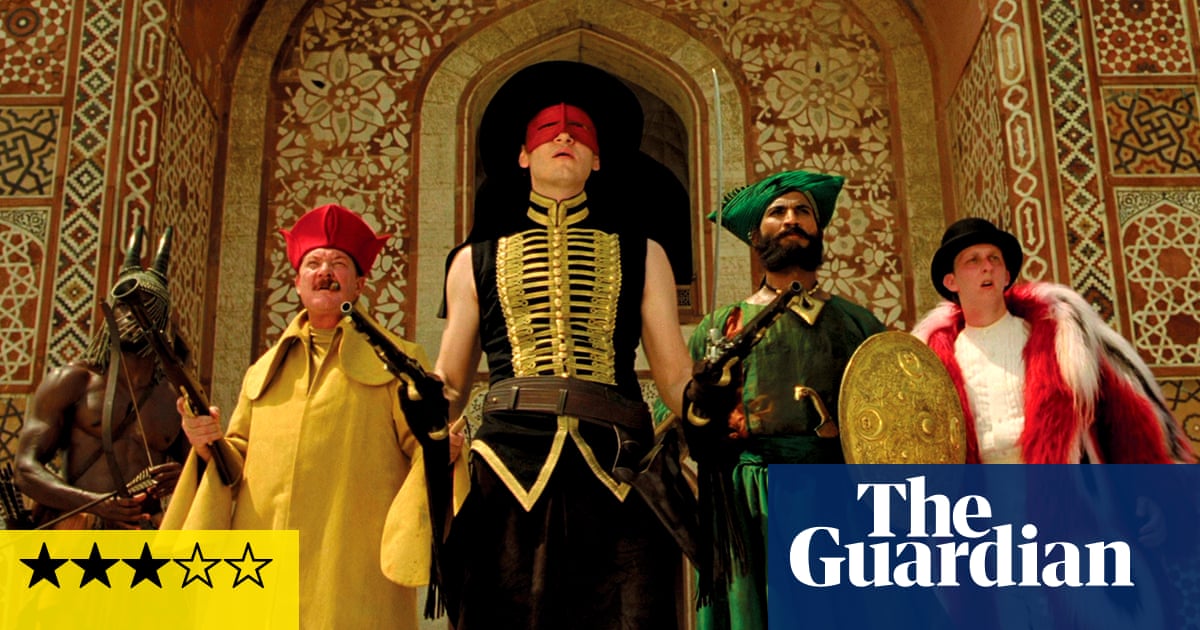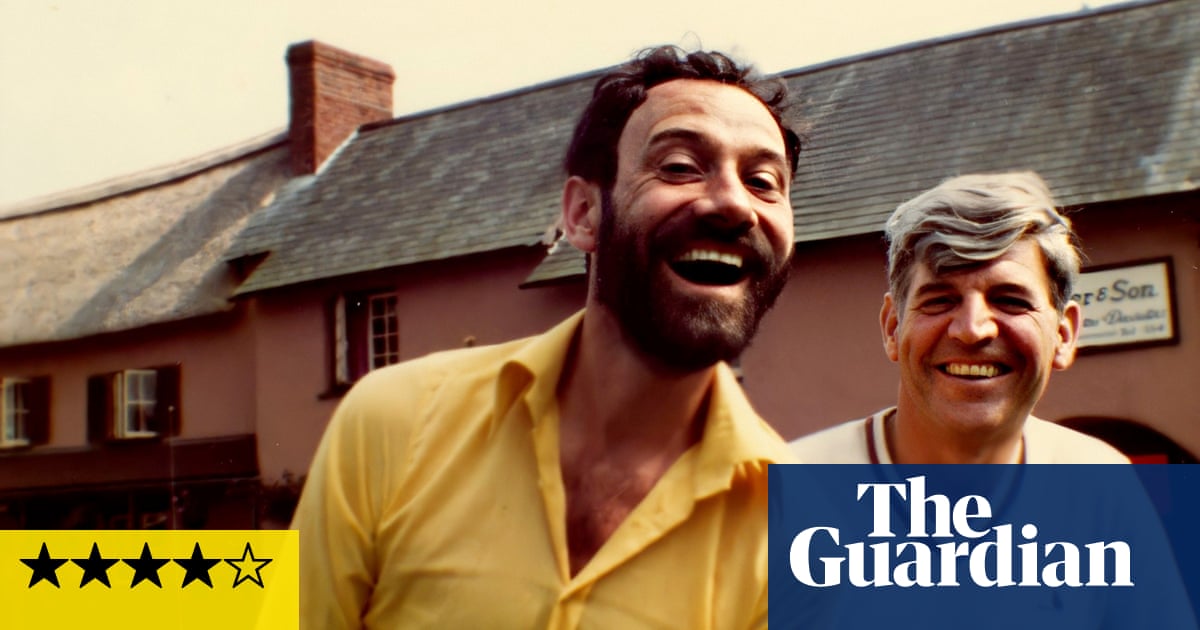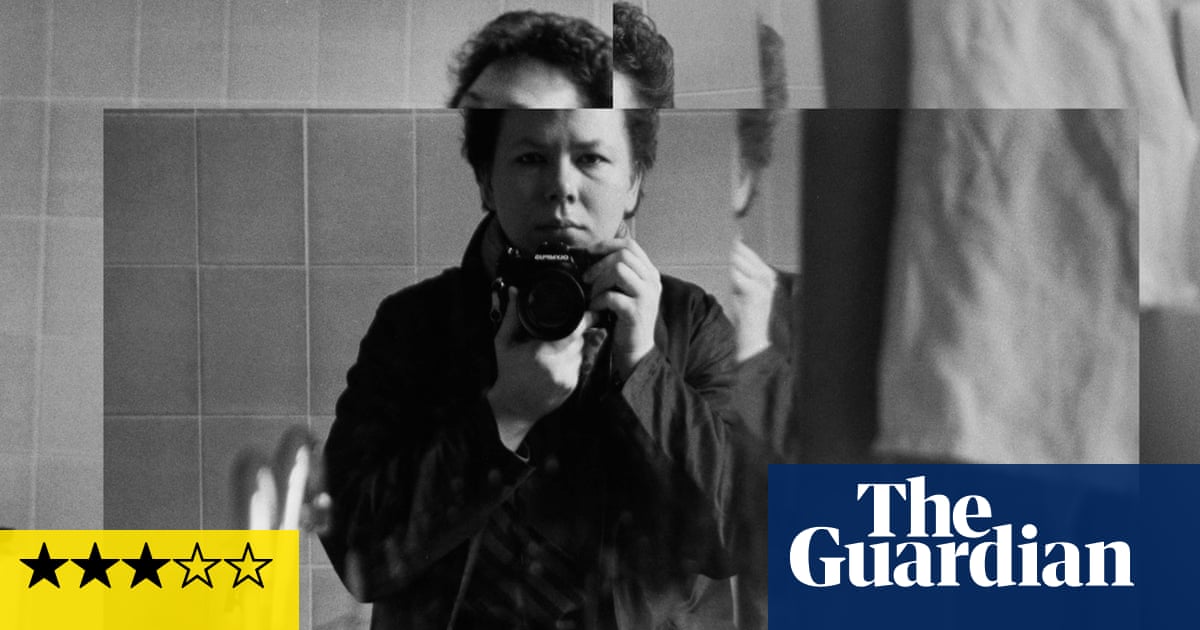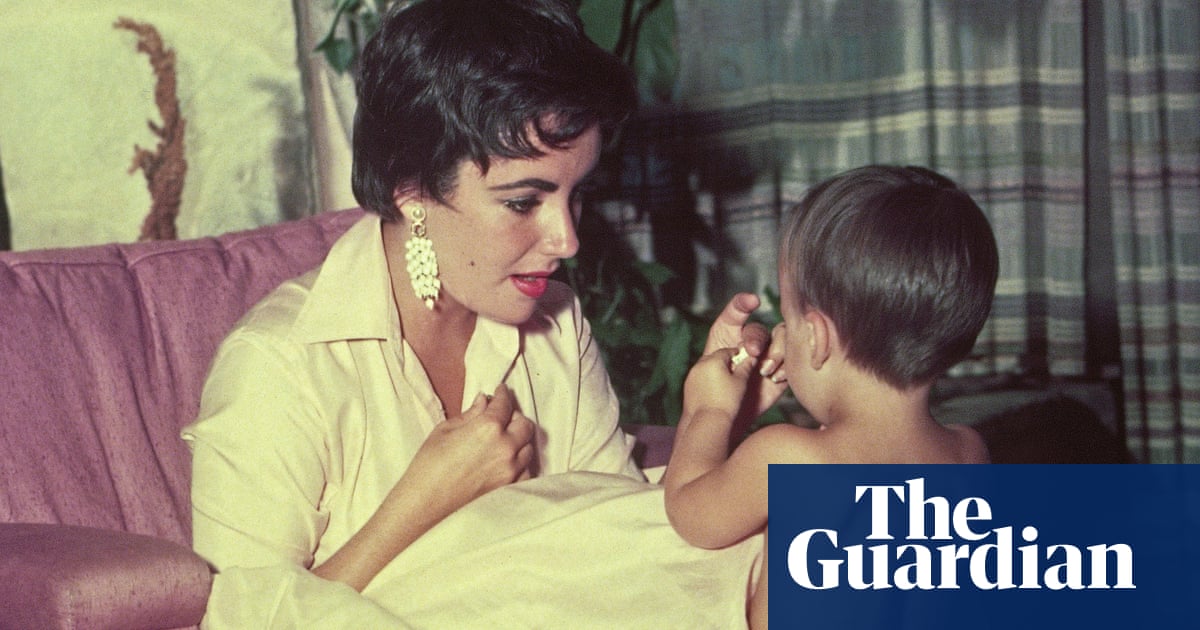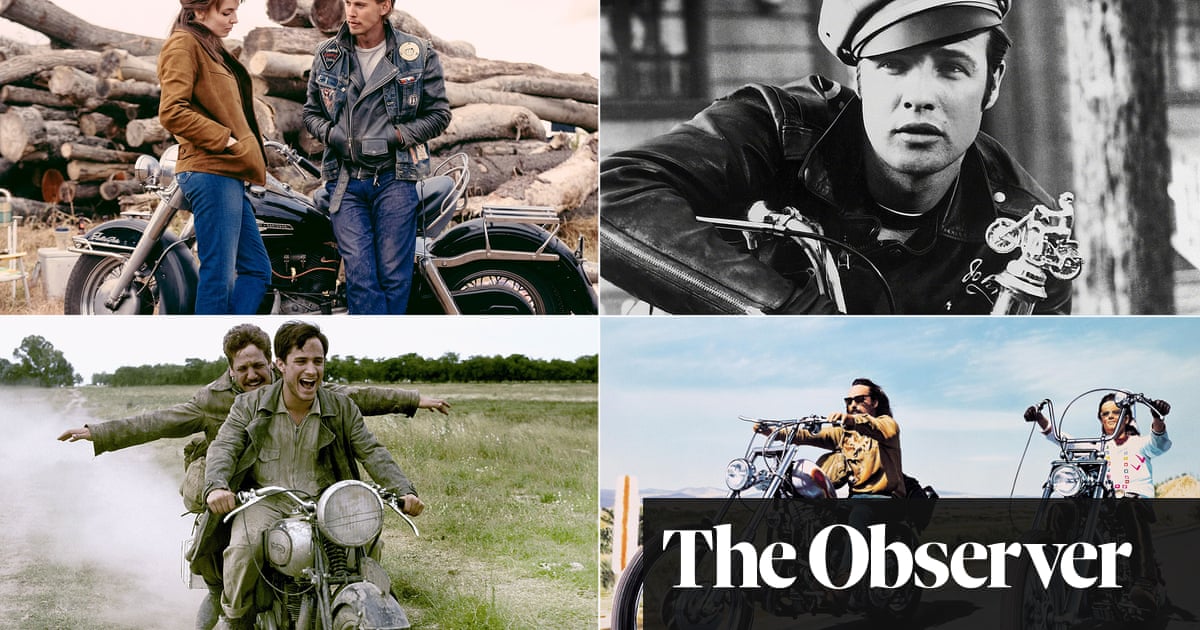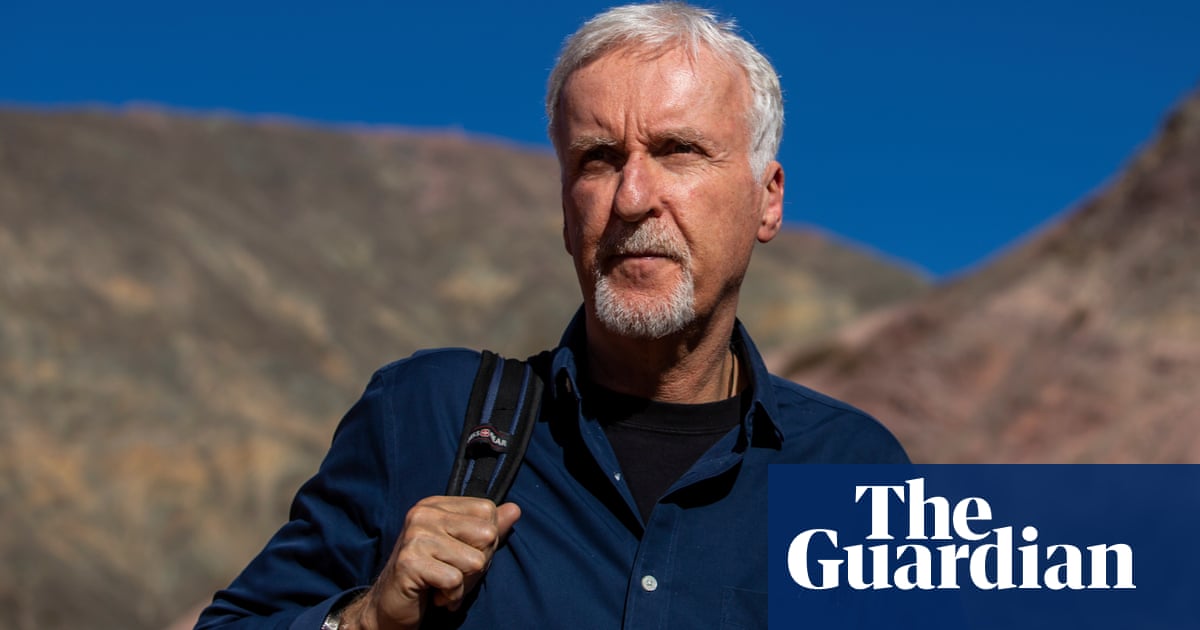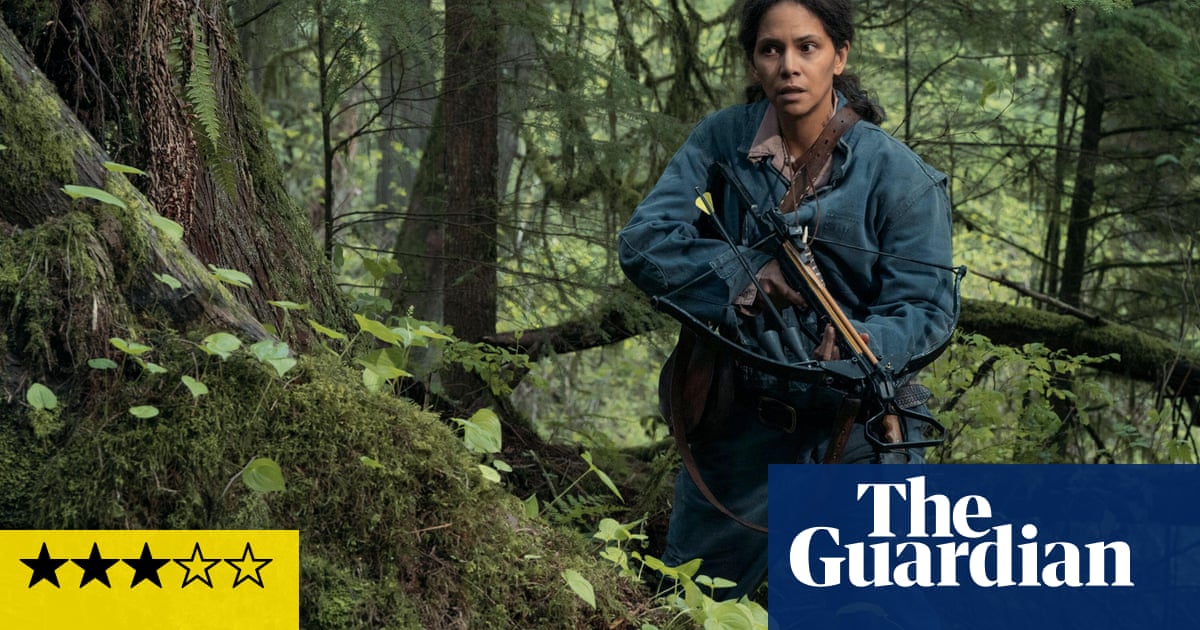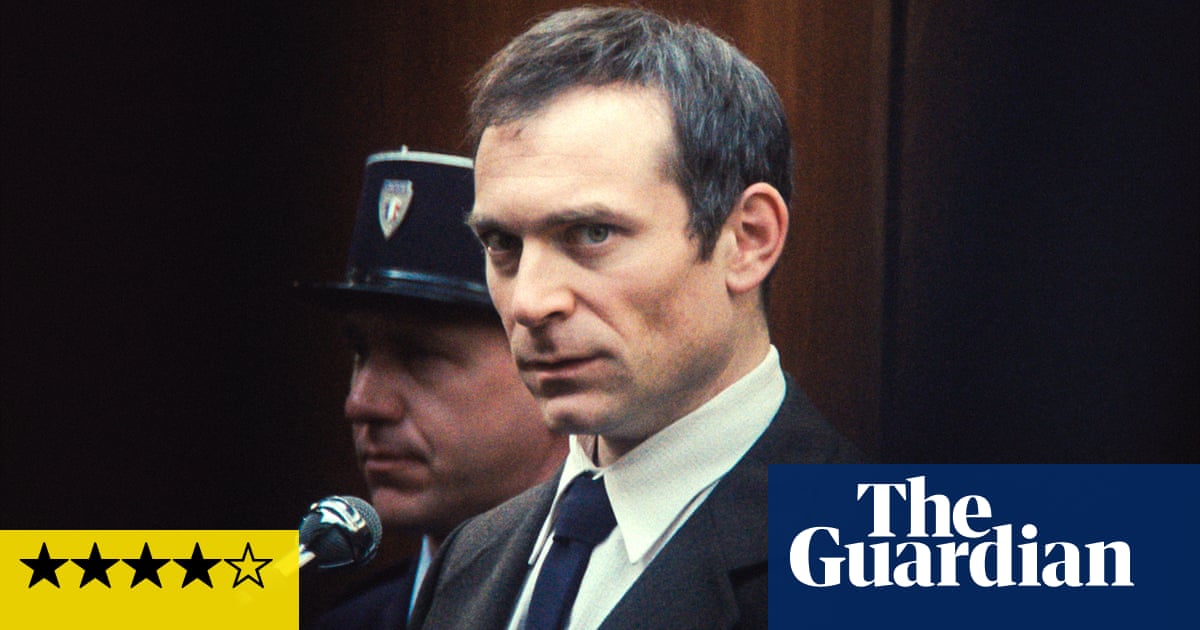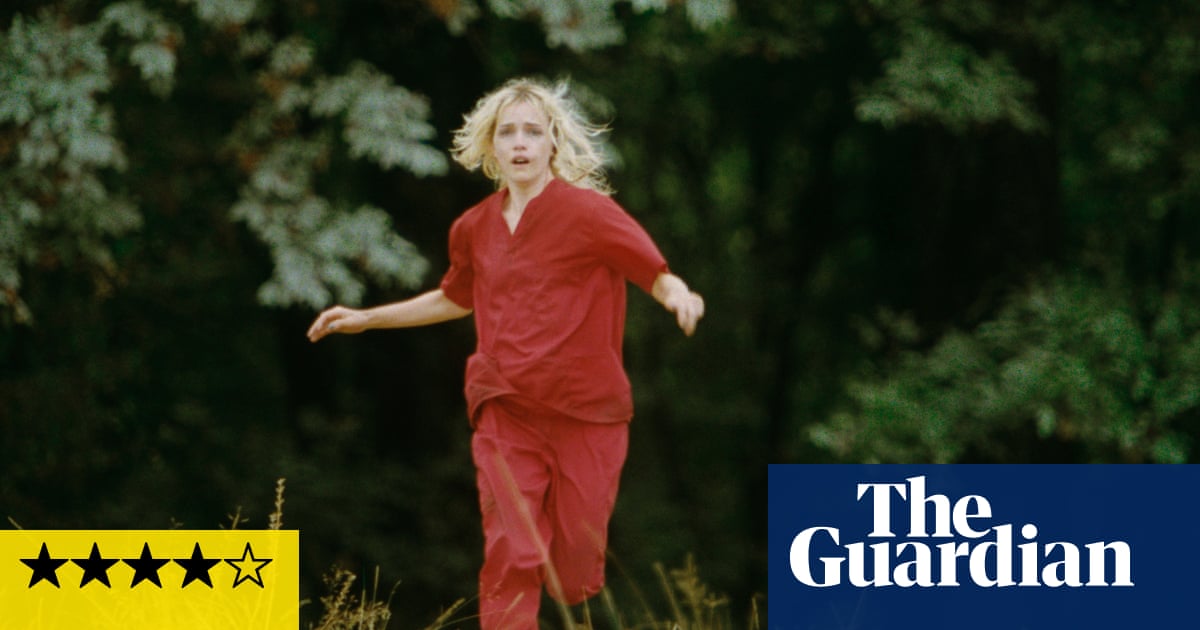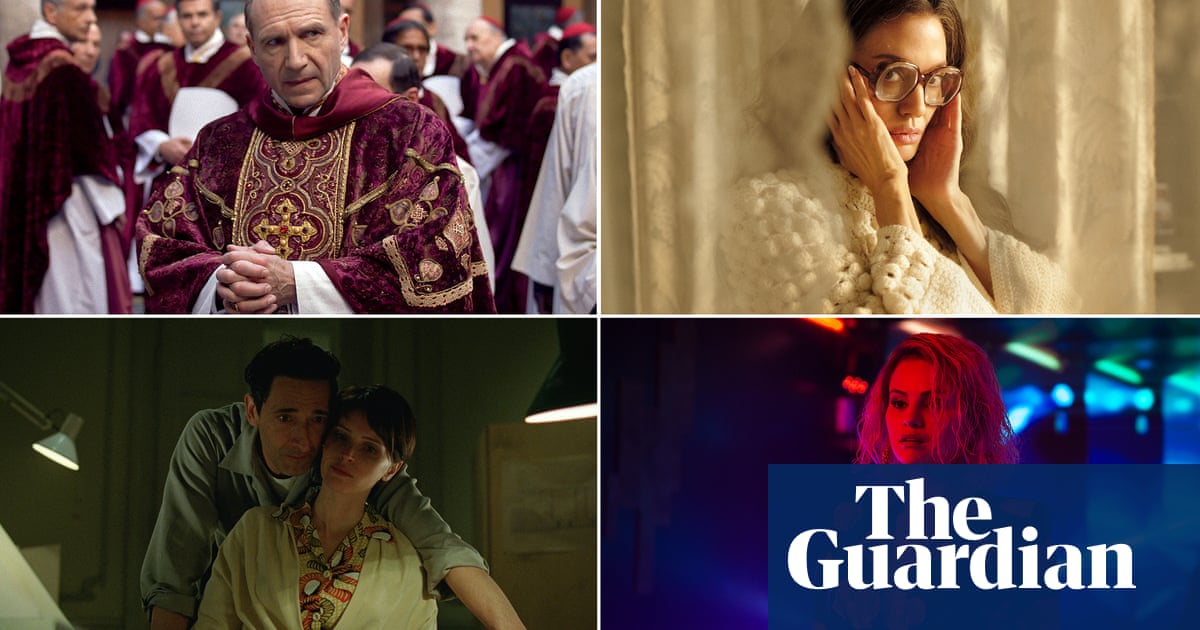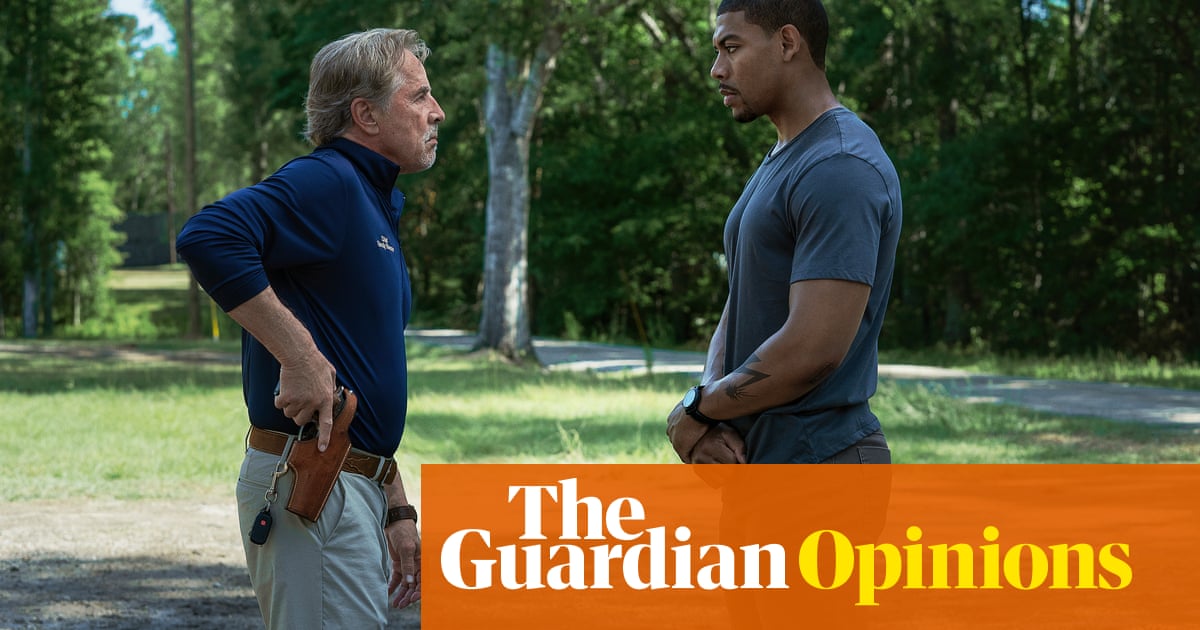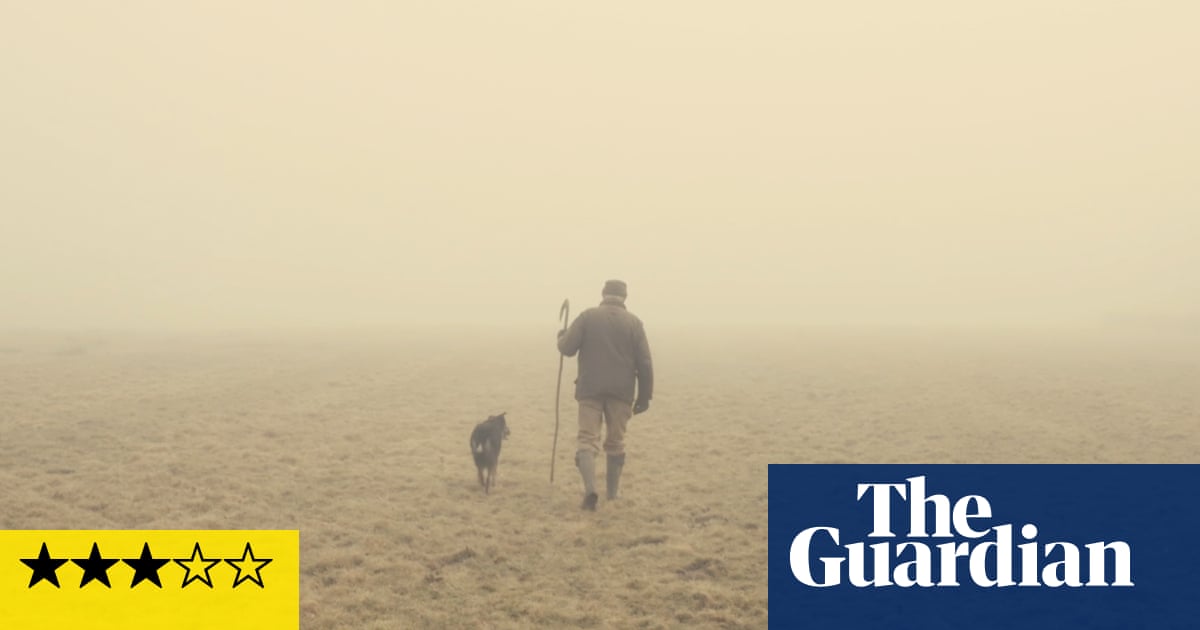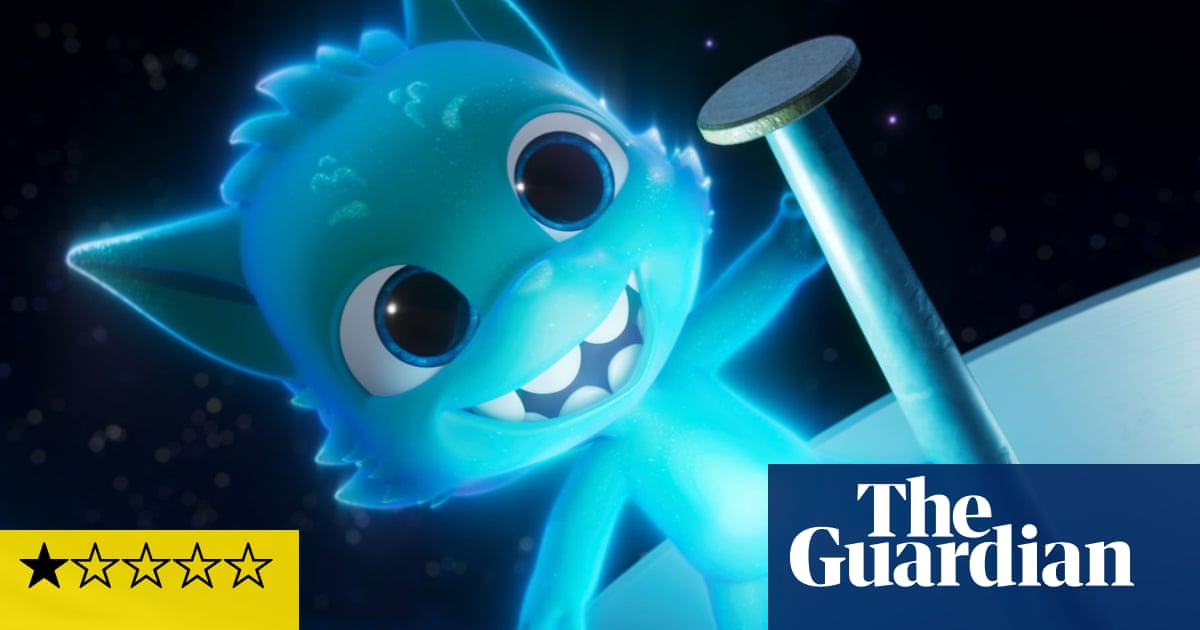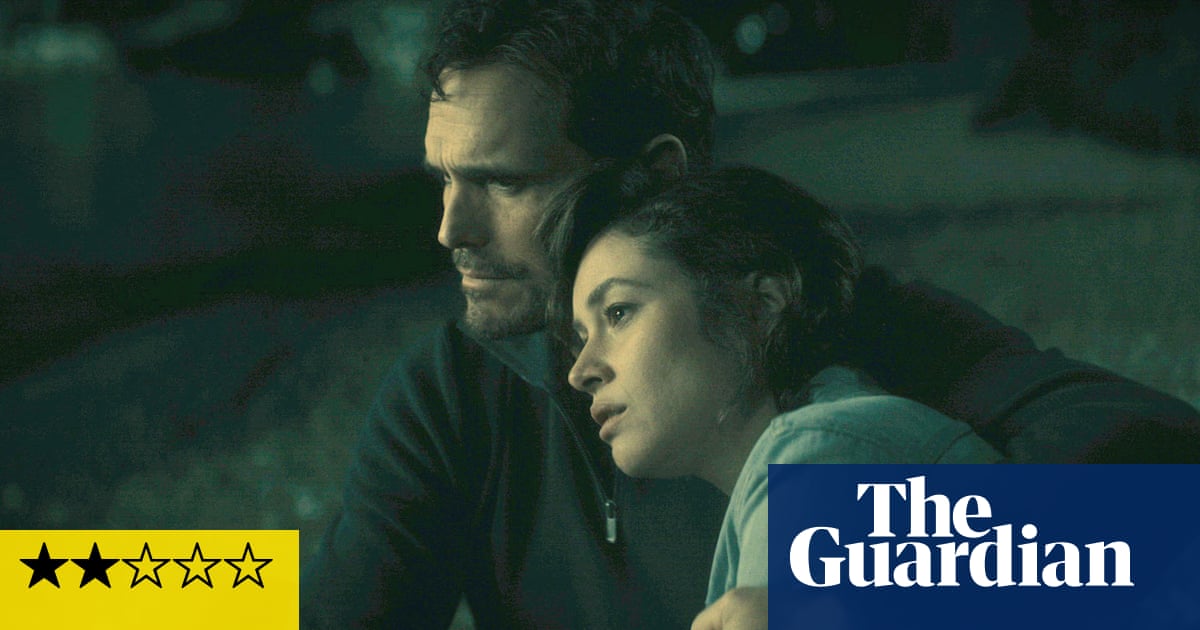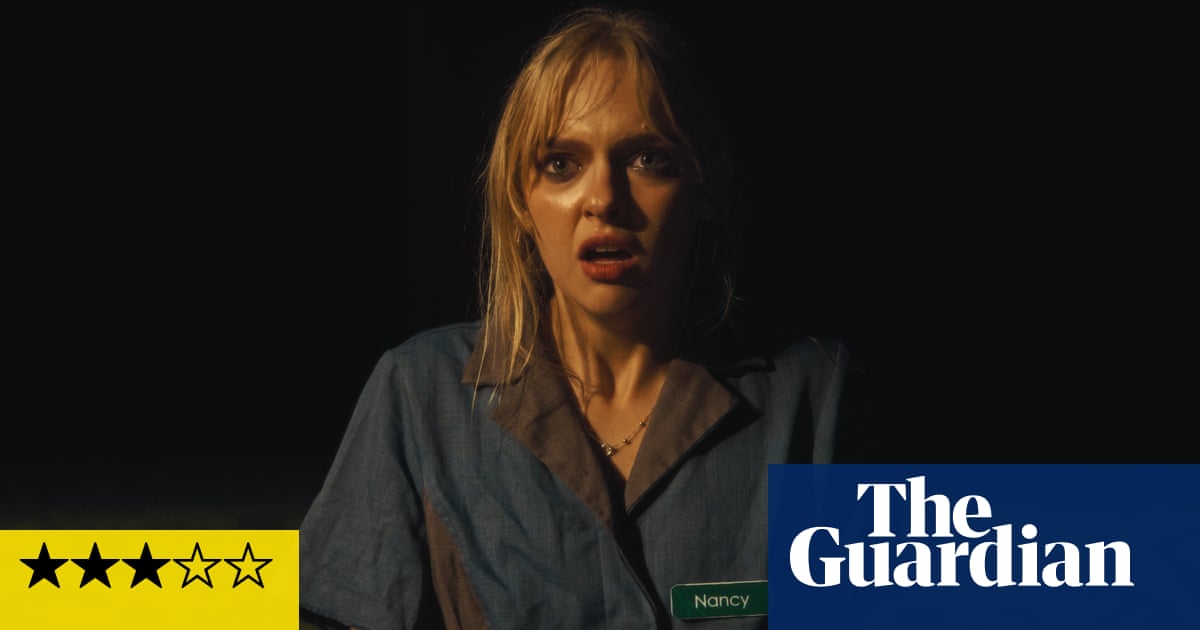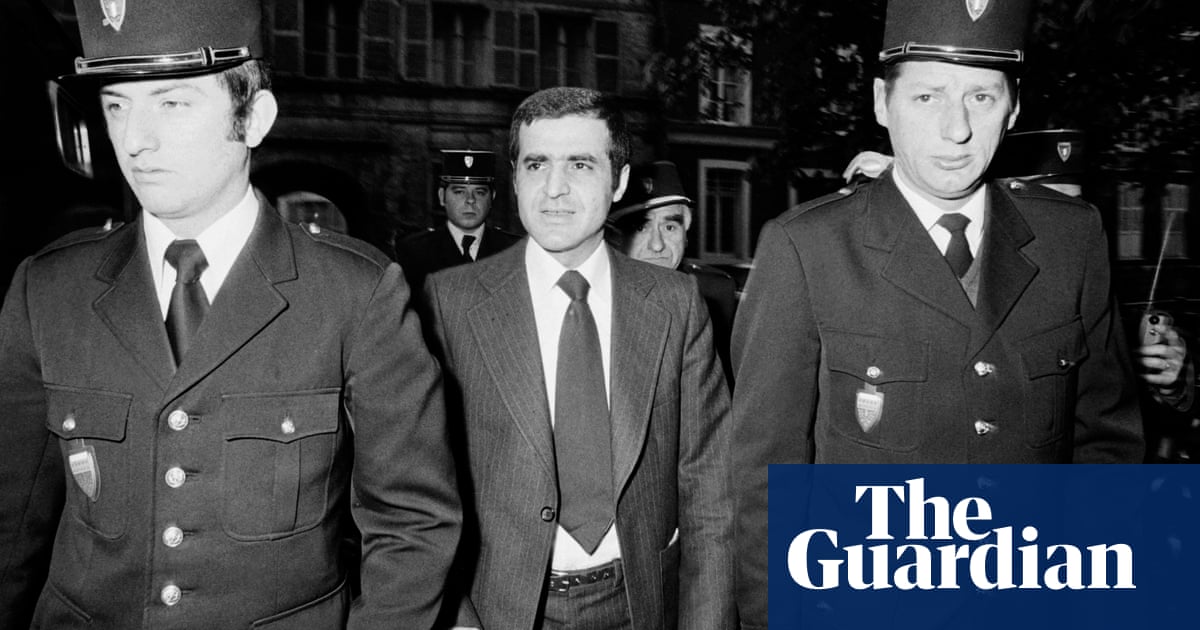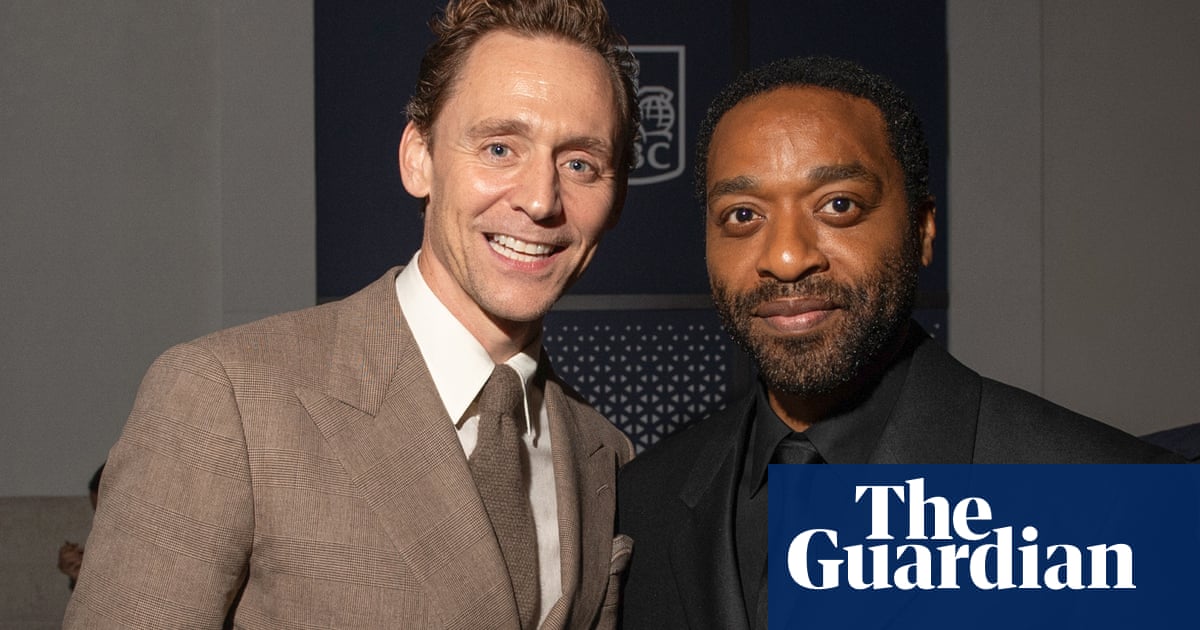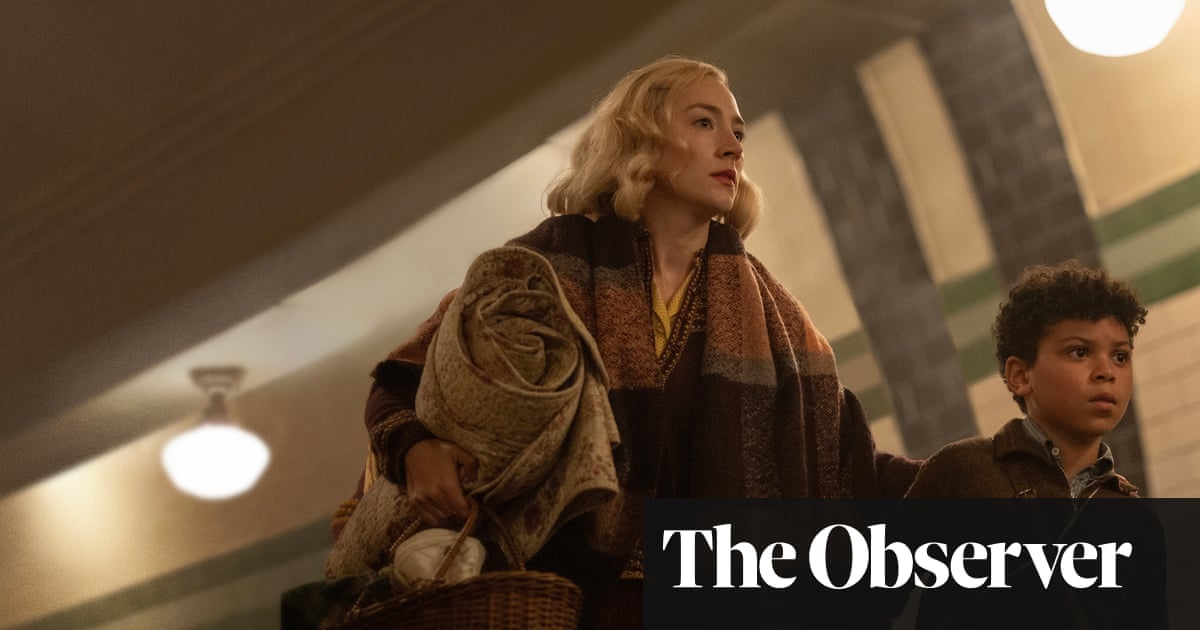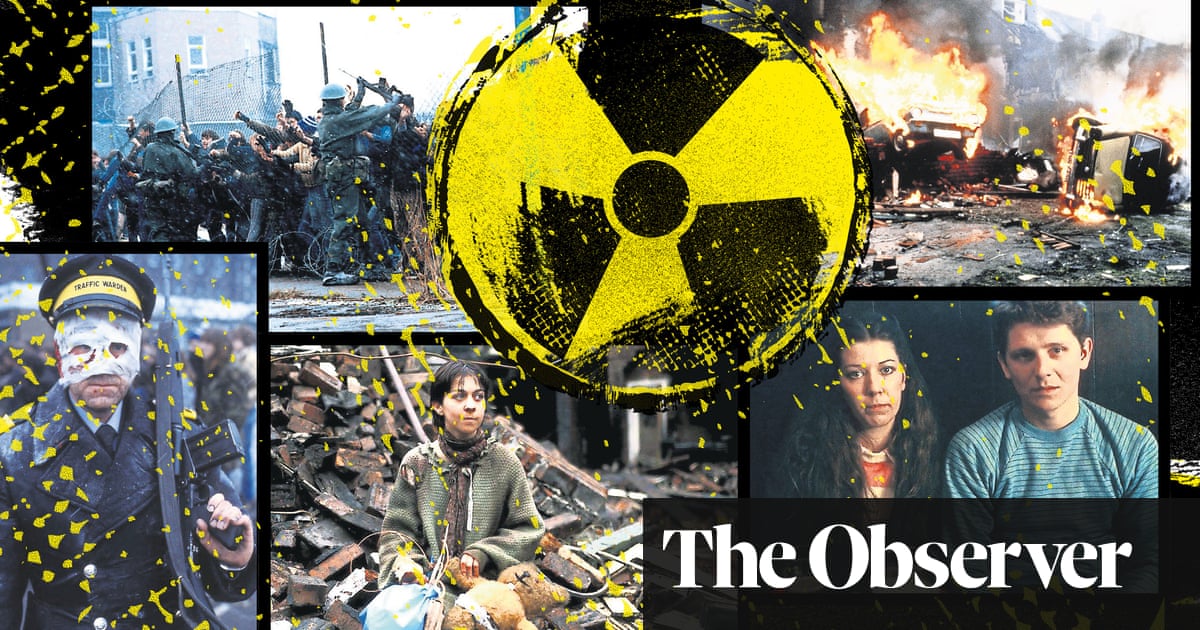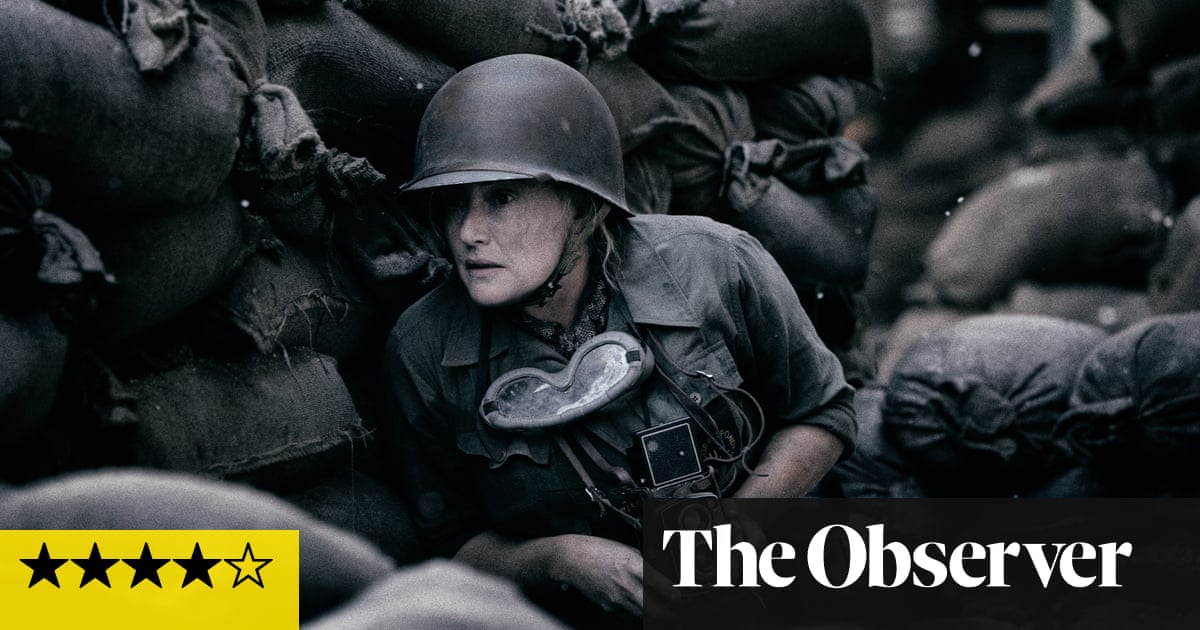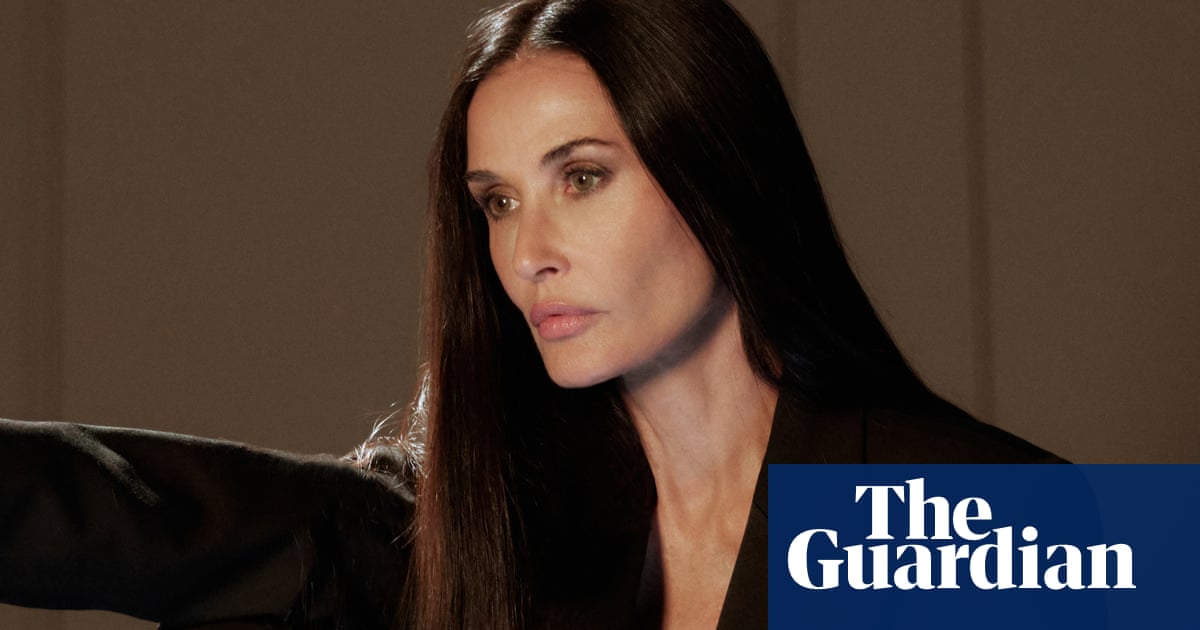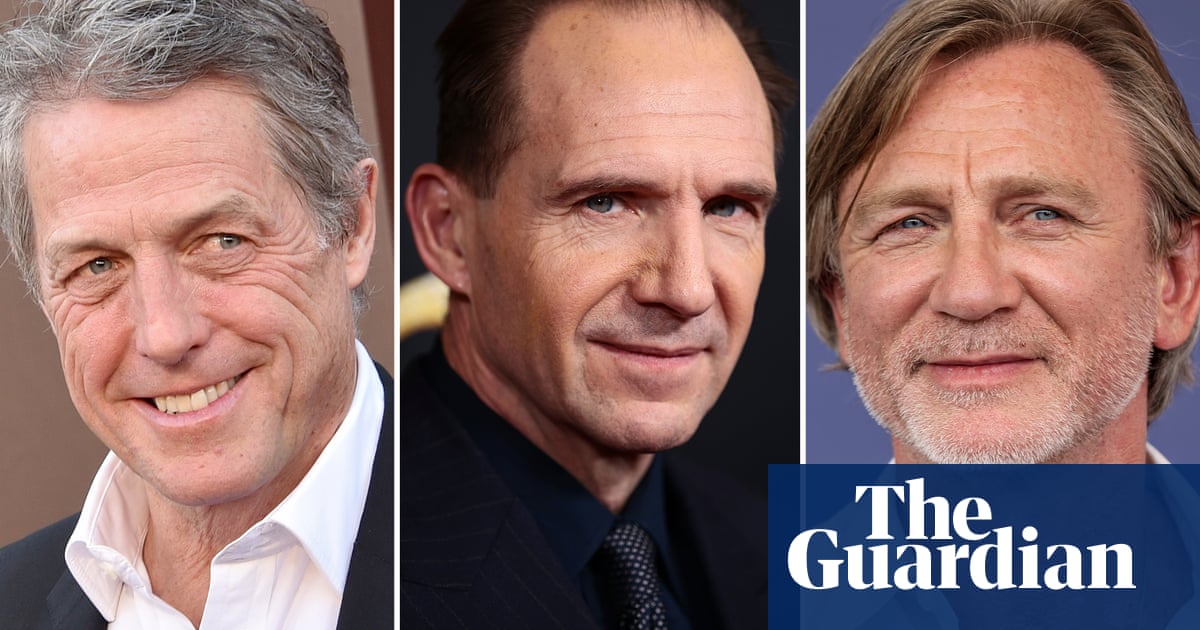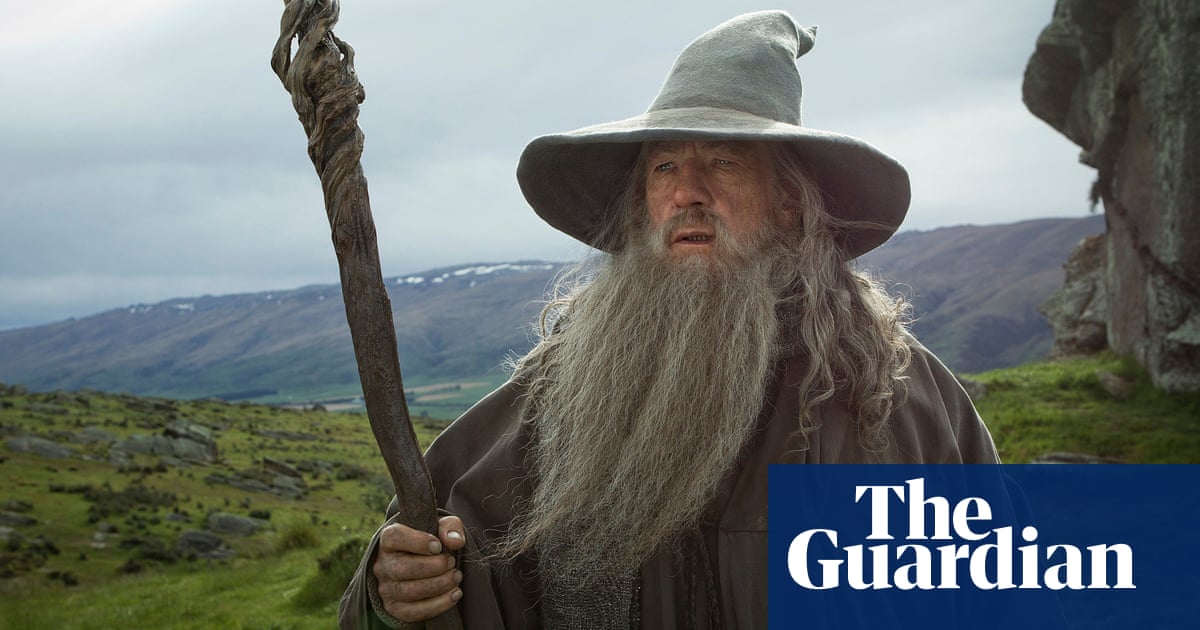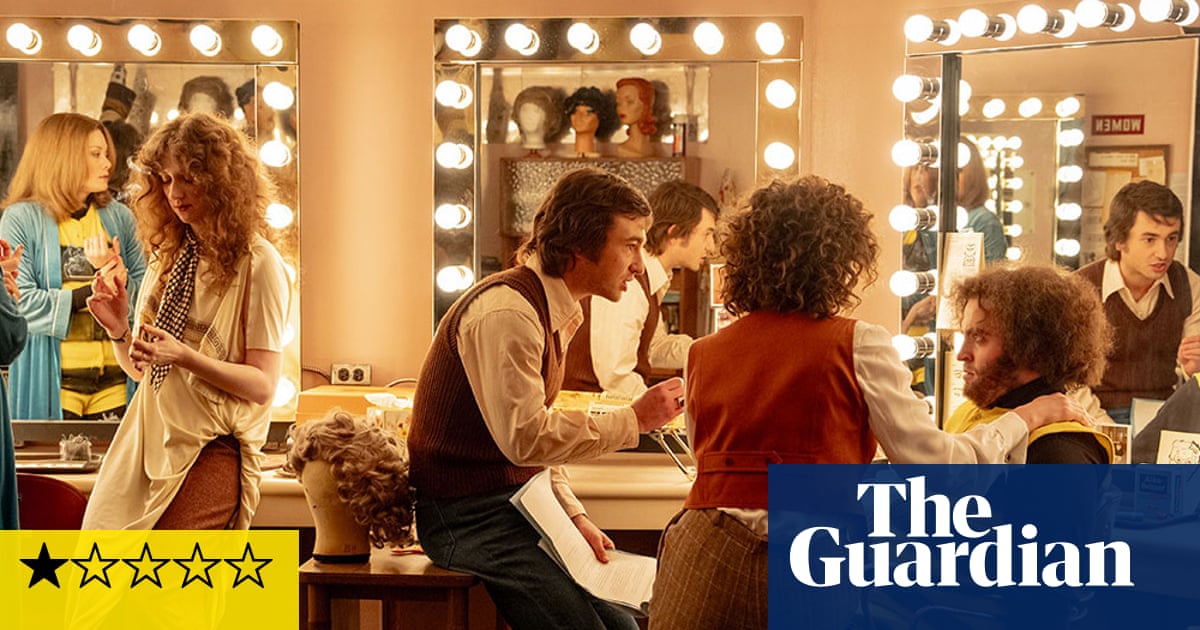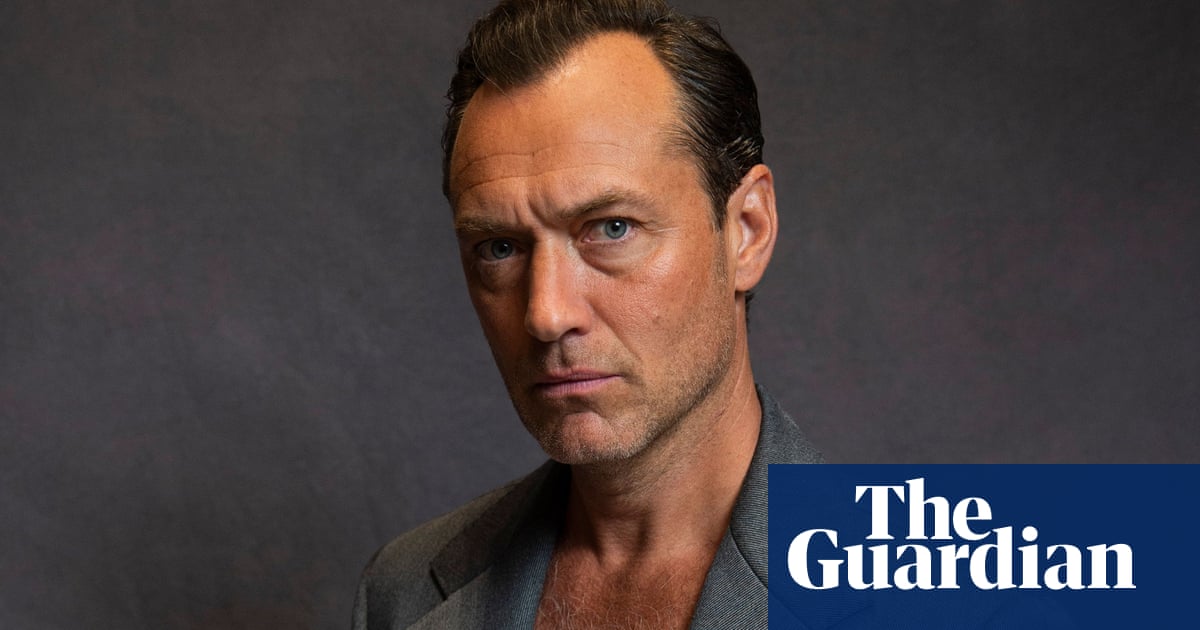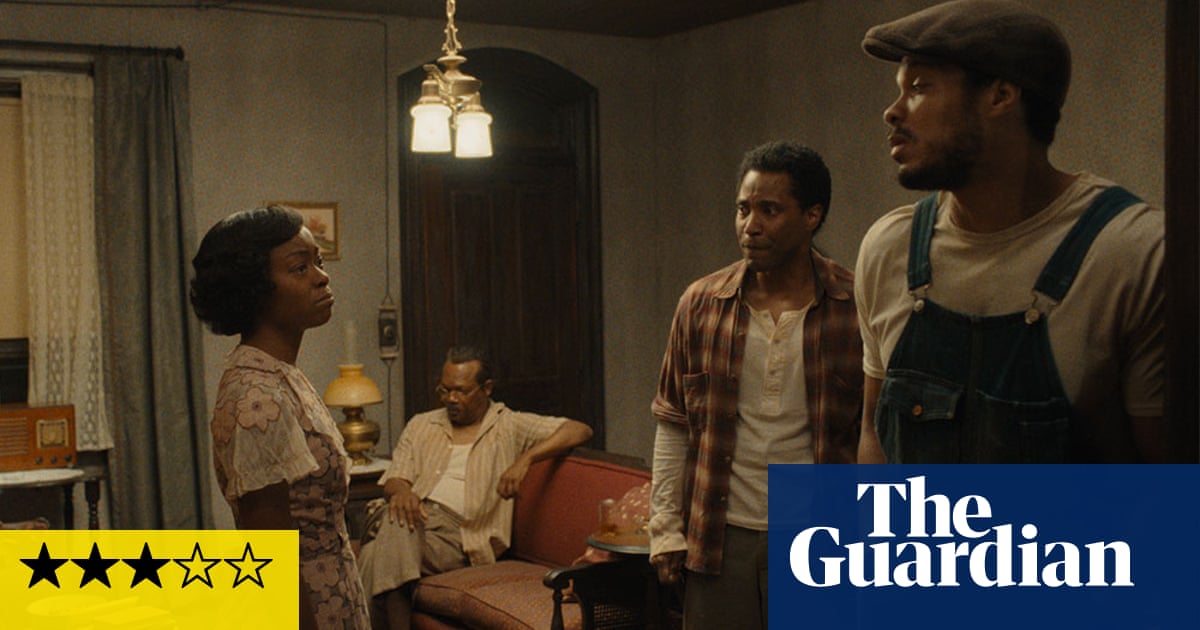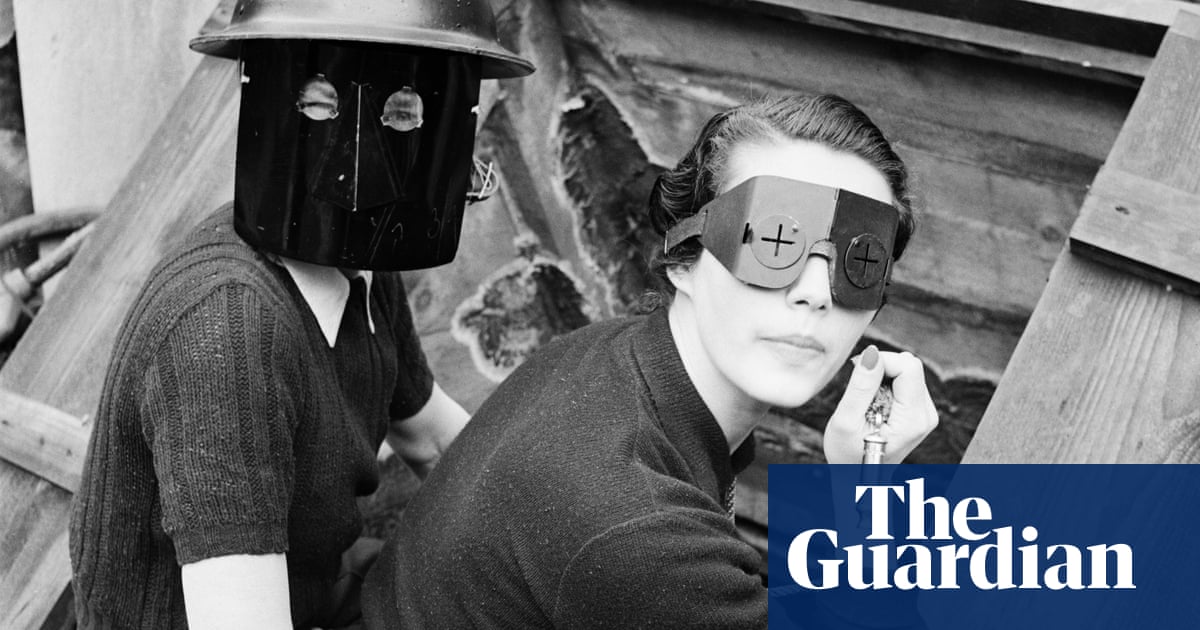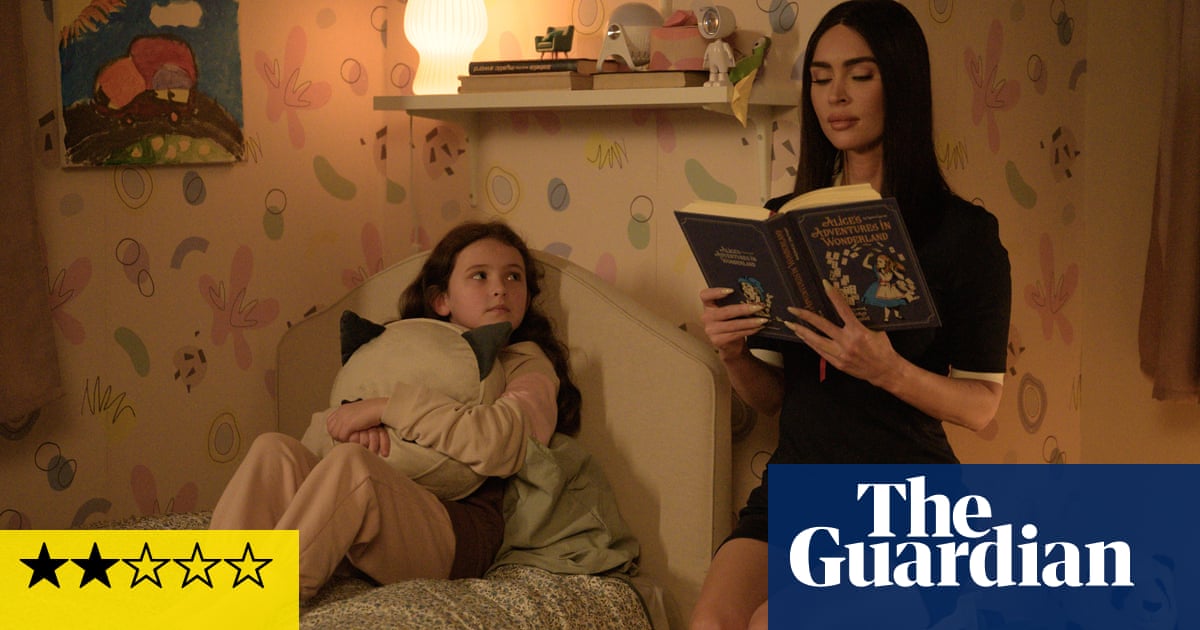Fantastical storytelling underpins Tarsem’s 2006 film, in which an injured stuntman relates an elaborate fable to a young girl
Tarsem Singh’s indulgent epic, produced by Spike Jonze and David Fincher, was little seen on its original release in 2006, and now gets a rerelease in a 4K restoration on the Mubi streaming platform. It’s certainly worth noticing, with its Gilliamesque surrealism, and its setting in Rajasthan, north-western India, offers wonderful landscapes. Its beguiling set pieces feature Justine Waddell playing some deadpan comedy as a gloriously costumed princess – although I have to admit that in general the film’s rather placid, stately, fantasy style can be exasperatingly inert.
The scene is Los Angeles in the early years of silent pictures; Lee Pace plays Roy, a stuntman who is now seriously, perhaps permanently, injured. He is laid up in hospital and deeply depressed after a dangerous fall filming a movie whose lead actress was once his girlfriend, but has now left him for the vapid male star. Roy is befriended by a little Romanian girl from the neighbouring children’s ward; this is Alexandria (played by Catinca Untaru, whose English dialogue is sometimes a little indistinct). Kindly, Roy offers to tell the wide-eyed Alexandria an epic story of adventure featuring five heroes battling a hateful governor, and the story comes to life before our eyes with Roy and Alexandria appearing in it and some whimsical muddling up of Indians and Native Americans. Continue reading...
http://dlvr.it/TDdK4V
Melayani berbagai kebutuhan pameran acara konser seminar gathering posko relaksasi dan sebagainya di wilayah jakarta bogor depok tangerang bekasi karawang dan sekitarnya
Sewa kursi pijat 081380783912
Sewa Kursi Pijat
Sewa Kursi Pijat 081380783912
Kunjungi mall PTC Pulogadung Lantai Dasar Kios Blok A70 Jakarta Timur
Atau Koja Trade Mall Jakarta Utara Lantai Dasar dan UG
Sangat cocok untuk berbagai kegiatan di Jabodetabek
Layanan Jasa dan Contoh Kegiatan
Contoh kegiatan atau acara di Jabodetabek yang cocok untuk menyediakan area relaksasi dengan kursi pijat:
- Pameran dagang
- Seminar bisnis
- Konferensi akademik
- Konser musik
- Festival kuliner
- Bazar amal
- Acara peluncuran produk
- Peresmian gedung baru
- Pameran otomotif
- Acara pernikahan
- Resepsi pernikahan
- Pameran properti
- Acara reuni sekolah
- Festival budaya
- Acara perusahaan
- Family gathering
- Pelatihan karyawan
- Seminar kesehatan
- Pameran buku
- Workshop seni
- Pameran teknologi
- Pameran fotografi
- Festival film
- Acara olahraga
- Pesta ulang tahun
- Kegiatan komunitas
- Acara kampus
- Wisuda
- Workshop kecantikan
- Pameran fashion
- Pameran kerajinan tangan
- Pameran seni rupa
- Pameran furnitur
- Festival anak
- Pameran hewan peliharaan
- Seminar parenting
- Pameran pernikahan
- Pameran elektronik
- Pameran game
- Pameran kecantikan
- Acara networking
- Festival
Bill Douglas: My Best Friend review – inspirational and tender portrait of a brilliant director
Jack Archer’s intimate documentary traces Douglas’s bond with social worker Peter Jewell with tremendous warmth
With enormous warmth, film-maker Jack Archer has made an intimate documentary about Peter Jewell, the London social worker who was also the lifelong best friend, inspirational collaborator and – in a way that is perhaps not entirely elucidated here – a non-sexual partner of film-maker Bill Douglas.
Jewell was as important to Douglas, perhaps, as Peter Pears was to Benjamin Britten. (“He never said ‘I love you’ or anything soppy like that … we often hugged and held hands,” says Jewell.) He was the real-life model of “Robert”, the well-educated Englishman in My Way Home from 1978, the third part of Douglas’s autobiographical trilogy; he befriends the unhappy working-class Scot Jamie (modelled, of course, on Douglas himself) while they are doing National Service in the Egyptian Suez canal zone (and in a subtle way, showing that his “way home” is not back to Scotland but forward to a more cultured and creative life elsewhere, although the Scotland of Douglas’s childhood would always be vital). Continue reading...
http://dlvr.it/TDcxQR
With enormous warmth, film-maker Jack Archer has made an intimate documentary about Peter Jewell, the London social worker who was also the lifelong best friend, inspirational collaborator and – in a way that is perhaps not entirely elucidated here – a non-sexual partner of film-maker Bill Douglas.
Jewell was as important to Douglas, perhaps, as Peter Pears was to Benjamin Britten. (“He never said ‘I love you’ or anything soppy like that … we often hugged and held hands,” says Jewell.) He was the real-life model of “Robert”, the well-educated Englishman in My Way Home from 1978, the third part of Douglas’s autobiographical trilogy; he befriends the unhappy working-class Scot Jamie (modelled, of course, on Douglas himself) while they are doing National Service in the Egyptian Suez canal zone (and in a subtle way, showing that his “way home” is not back to Scotland but forward to a more cultured and creative life elsewhere, although the Scotland of Douglas’s childhood would always be vital). Continue reading...
http://dlvr.it/TDcxQR
Detective Conan: The Million-Dollar Pentagram review – cult anime goes on wild treasure hunt
The latest outing for the high school sleuth sees him join forces with his arch enemy, a master thief. Despite some flashes of brilliance, the script soon becomes convoluted
With its ingenious murder mysteries and thrilling solutions, Case Closed – also known as Detective Conan – has long been one of the most beloved manga series in Japan and abroad. In addition to an anime show running since 1996, a Detective Conan feature film has dropped almost every year. The highest grossing Japanese release of 2024 so far, this latest addition to the franchise also marks a milestone for animator Chika Nagaoka, the first woman to direct a Detective Conan movie.
For the uninitiated, the opening credits deftly recap the characters’ backgrounds in under two minutes. After a run-in with a secret crime syndicate, high school detective Shinichi Kudo is forced to take a mysterious pill, which shrinks his body to that of a seven-year-old. He takes up the name Conan – after Sherlock Holmes’s famous author of course – and continues to flex his analytical deductions while living with his crush Ran and her detective father Kogoro Mouri. Very few people know his real identity; two of them are Heiji Hattori, another teenage sleuth, and Kaitou Kid, a master jewel thief. Continue reading...
http://dlvr.it/TDcZyw
With its ingenious murder mysteries and thrilling solutions, Case Closed – also known as Detective Conan – has long been one of the most beloved manga series in Japan and abroad. In addition to an anime show running since 1996, a Detective Conan feature film has dropped almost every year. The highest grossing Japanese release of 2024 so far, this latest addition to the franchise also marks a milestone for animator Chika Nagaoka, the first woman to direct a Detective Conan movie.
For the uninitiated, the opening credits deftly recap the characters’ backgrounds in under two minutes. After a run-in with a secret crime syndicate, high school detective Shinichi Kudo is forced to take a mysterious pill, which shrinks his body to that of a seven-year-old. He takes up the name Conan – after Sherlock Holmes’s famous author of course – and continues to flex his analytical deductions while living with his crush Ran and her detective father Kogoro Mouri. Very few people know his real identity; two of them are Heiji Hattori, another teenage sleuth, and Kaitou Kid, a master jewel thief. Continue reading...
http://dlvr.it/TDcZyw
I’m Not Everything I Want to Be review – sex, fashion and addiction from Czech Nan Goldin
Libuše Jarcovjáková narrates her own life story from career obscurity to capturing the Prague underground and the fall of the Berlin Wall
It’s likely that not too many people will have heard of photographer Libuše Jarcovjáková, but plenty of poseurs will pretend they were always fans after they see this. As it happens, the film makes it pretty clear that she wasn’t that well-known outside cognoscenti circles until a major 2019 show in Arles won rave reviews; the struggle with obscurity, her refusal to give up, is one of the things that makes her such a winning subject here. That, and her gruff, deadpan voice which narrates this autobiographical reflection, told entirely through her photography, spiced up with a cannily deployed soundtrack of Foley noises and music, along with some nimble editing.
Unfurled in unfussy chronological order, the film recounts how Jarcovjáková was born to a pair of artists who struggled themselves to establish their reputations in post-second world war Prague where only the most socialist survived. From a young age, she wanted to be a photographer, but her applications to the equivalent of art school were repeatedly rejected as she didn’t have the right kind of proletariat background. Around the time Russian tanks were occupying Prague in 1968, she was working in a print works where she took striking shots of her co-workers, often asleep or drunk on the job. There was a husband and other lovers who came and went, a couple of abortions, and an unfeasible bit of luck that saw her travelling to Japan where she found crucial career supporters, and then a return to Prague where she drifted into the city’s underground queer scene. Continue reading...
http://dlvr.it/TDcHDQ
It’s likely that not too many people will have heard of photographer Libuše Jarcovjáková, but plenty of poseurs will pretend they were always fans after they see this. As it happens, the film makes it pretty clear that she wasn’t that well-known outside cognoscenti circles until a major 2019 show in Arles won rave reviews; the struggle with obscurity, her refusal to give up, is one of the things that makes her such a winning subject here. That, and her gruff, deadpan voice which narrates this autobiographical reflection, told entirely through her photography, spiced up with a cannily deployed soundtrack of Foley noises and music, along with some nimble editing.
Unfurled in unfussy chronological order, the film recounts how Jarcovjáková was born to a pair of artists who struggled themselves to establish their reputations in post-second world war Prague where only the most socialist survived. From a young age, she wanted to be a photographer, but her applications to the equivalent of art school were repeatedly rejected as she didn’t have the right kind of proletariat background. Around the time Russian tanks were occupying Prague in 1968, she was working in a print works where she took striking shots of her co-workers, often asleep or drunk on the job. There was a husband and other lovers who came and went, a couple of abortions, and an unfeasible bit of luck that saw her travelling to Japan where she found crucial career supporters, and then a return to Prague where she drifted into the city’s underground queer scene. Continue reading...
http://dlvr.it/TDcHDQ
Margot Robbie and Jacob Elordi to lead Emerald Fennell’s Wuthering Heights
The Australian stars will head up a new adaptation from the Promising Young Woman and Saltburn film-maker
Margot Robbie and Jacob Elordi are set to lead a new adaptation of Wuthering Heights from Emerald Fennell.
The Oscar winner, known for Promising Young Woman and last year’s Saltburn, had teased the project on social media but Deadline is now reporting the two actors attached to the project. Continue reading...
http://dlvr.it/TDbh0l
Margot Robbie and Jacob Elordi are set to lead a new adaptation of Wuthering Heights from Emerald Fennell.
The Oscar winner, known for Promising Young Woman and last year’s Saltburn, had teased the project on social media but Deadline is now reporting the two actors attached to the project. Continue reading...
http://dlvr.it/TDbh0l
Post your questions for Isabelle Huppert
She’s worked with most of the great names of European cinema, from Godard to Haneke, and on one of Hollywood’s greatest disasters. Now she’s ready for your closeup quizzing
France has quite a few grandes dames of cinema, with Catherine Deneuve, Juliette Binoche and Isabelle Adjani all very much in the game. But none can hold much of a candle to Isabelle Huppert, who is firing on all cylinders as she enters her 70s, in her sixth decade of headline acting performances. Tightly wound and fiery, while simultaneously self-contained and tough as nails, Huppert’s acting persona has been instrumental to a string of masterpieces – and even if the film around her isn’t that great, she’s always magnificent to watch.
With so many amazing credits, stretching back to the 1970s, it’s hard to pick out a few, but we’ll have a go: early attention-grabbers like The Lacemaker and The Judge and the Assassin that graduated to fully-fledged lead performances in Loulou and Claude Chabrol’s Madame Bovary. Then the really extraordinary ones: La Cérémonie, Ruth Rendell’s scary domestic thriller; the traumatic and traumatising The Piano Teacher directed by Michael Haneke; Claire Denis’ steely White Material; and, of course, Paul Verhoeven’s transgressive rape thriller Elle, for which she was nominated for an Oscar. Continue reading...
http://dlvr.it/TDZm81
France has quite a few grandes dames of cinema, with Catherine Deneuve, Juliette Binoche and Isabelle Adjani all very much in the game. But none can hold much of a candle to Isabelle Huppert, who is firing on all cylinders as she enters her 70s, in her sixth decade of headline acting performances. Tightly wound and fiery, while simultaneously self-contained and tough as nails, Huppert’s acting persona has been instrumental to a string of masterpieces – and even if the film around her isn’t that great, she’s always magnificent to watch.
With so many amazing credits, stretching back to the 1970s, it’s hard to pick out a few, but we’ll have a go: early attention-grabbers like The Lacemaker and The Judge and the Assassin that graduated to fully-fledged lead performances in Loulou and Claude Chabrol’s Madame Bovary. Then the really extraordinary ones: La Cérémonie, Ruth Rendell’s scary domestic thriller; the traumatic and traumatising The Piano Teacher directed by Michael Haneke; Claire Denis’ steely White Material; and, of course, Paul Verhoeven’s transgressive rape thriller Elle, for which she was nominated for an Oscar. Continue reading...
http://dlvr.it/TDZm81
Survive review – smart, surrealist disaster flick filled with arresting dream-like imagery
Low-budget limitations work in this French thriller’s favour, in which Earth is turned upside down
At one point in this smart, low-budget French disaster movie/post-apocalyptic thriller, teenager Ben (Lucas Ebel) pees into an unplumbed toilet dumped in the wasteland. It’s a moment emblematic of Frédéric Jardin’s film; it makes little practical sense, but is packed with arresting images and proceeds with something close to the dream logic of Luc Besson’s debut The Last Battle, and the great comic-book artist Moebius.
Ben is on a Caribbean family cruise with his revoltingly-in-love parents, Julia (Émilie Dequenne) and Tom (Andreas Pietschmann), and his just-plain-revolting older sister, Cassie (Lisa Delamar). After nervy whales graze their yacht, satellites fall burning through the atmosphere and a cataclysm begins, they awake to find their boat stranded on top of a promontory in an infinite desert. Go-getter dad Tom, who likes solutions, quickly finds the answer with his compass – the Earth’s poles have reversed, dumping the oceans where the land previously was, presumably killing millions, and leaving the boat high and dry. Continue reading...
http://dlvr.it/TDZQPx
At one point in this smart, low-budget French disaster movie/post-apocalyptic thriller, teenager Ben (Lucas Ebel) pees into an unplumbed toilet dumped in the wasteland. It’s a moment emblematic of Frédéric Jardin’s film; it makes little practical sense, but is packed with arresting images and proceeds with something close to the dream logic of Luc Besson’s debut The Last Battle, and the great comic-book artist Moebius.
Ben is on a Caribbean family cruise with his revoltingly-in-love parents, Julia (Émilie Dequenne) and Tom (Andreas Pietschmann), and his just-plain-revolting older sister, Cassie (Lisa Delamar). After nervy whales graze their yacht, satellites fall burning through the atmosphere and a cataclysm begins, they awake to find their boat stranded on top of a promontory in an infinite desert. Go-getter dad Tom, who likes solutions, quickly finds the answer with his compass – the Earth’s poles have reversed, dumping the oceans where the land previously was, presumably killing millions, and leaving the boat high and dry. Continue reading...
http://dlvr.it/TDZQPx
The Invention of the Other review – fascinating first glimpse of uncontacted Amazon tribe
Bruno Jorge’s quietly observed film has an added poignance as the leader of the expedition to immunise one of Brazil’s isolated tribes is murdered activist Bruno Pereira
‘It doesn’t hurt to get your image,” says one man to another, nodding towards the camera. Both men are Korubo, an Indigenous tribe that lives deep in the Amazon rainforest. The man hesitant about being filmed has never seen a camera before. He belongs to an “uncontacted” group, who have lived completely isolated from the outside world – until now. This first contact is documented by film-maker Bruno Jorge in his fascinating, occasionally frustrating film – two-and-a-half hours of observation with no added frills. No interviews, no context, no explainers.
Jorge follows a 2019 expedition organised by Funai, Brazil’s agency for Indigenous people, which as a rule has a no-contact policy with isolated tribes. This expedition is necessary to immunise the uncontacted group of Korubo and to reunite them with family members who were separated during a conflict in 2015 with a neighbouring tribe. The moment of contact is extraordinary. Korubo guide Txitxopi, who is part of the expedition team, hasn’t seen his brother since the conflict. They hunch down chanting, stroking each other’s heads. Little boys stand around to watch, some of them with pet baby monkeys wrapped around their necks like scarves. I couldn’t take my eyes off it all. Continue reading...
http://dlvr.it/TDZ2zs
‘It doesn’t hurt to get your image,” says one man to another, nodding towards the camera. Both men are Korubo, an Indigenous tribe that lives deep in the Amazon rainforest. The man hesitant about being filmed has never seen a camera before. He belongs to an “uncontacted” group, who have lived completely isolated from the outside world – until now. This first contact is documented by film-maker Bruno Jorge in his fascinating, occasionally frustrating film – two-and-a-half hours of observation with no added frills. No interviews, no context, no explainers.
Jorge follows a 2019 expedition organised by Funai, Brazil’s agency for Indigenous people, which as a rule has a no-contact policy with isolated tribes. This expedition is necessary to immunise the uncontacted group of Korubo and to reunite them with family members who were separated during a conflict in 2015 with a neighbouring tribe. The moment of contact is extraordinary. Korubo guide Txitxopi, who is part of the expedition team, hasn’t seen his brother since the conflict. They hunch down chanting, stroking each other’s heads. Little boys stand around to watch, some of them with pet baby monkeys wrapped around their necks like scarves. I couldn’t take my eyes off it all. Continue reading...
http://dlvr.it/TDZ2zs
The hidden life of Elizabeth Taylor – as seen by her son: ‘Her love for Richard Burton never went away’
She despised hypocrisy and was fiercely loyal to her friends, while navigating the pressures and pleasures of being the world’s biggest star. Chris Wilding discusses the legend and legacy of the mother he loved
Chris Wilding is a shy man approaching 70. As a little boy, he was also shy. He used to get embarrassed when his mother turned up at school for parents’ day. Everybody made such a hoo-ha about it. There she would be, in her furs and finery, done up to the nines. She was so famous and infamous, sexy and scandalous, and he would never hear the end of it. And yet to him she was just Mom.
Elizabeth Taylor was the world’s best-known actress, becoming a global celebrity at 12 after starring in National Velvet. By the age of 35, she had won two Oscars, first for playing sex worker Gloria Wandrous in the 1960 film BUtterfield 8, which she described as “a piece of shit”, and then six years later for her brilliantly visceral performance as Martha in Who’s Afraid of Virginia Woolf? Continue reading...
http://dlvr.it/TDYpwQ
Chris Wilding is a shy man approaching 70. As a little boy, he was also shy. He used to get embarrassed when his mother turned up at school for parents’ day. Everybody made such a hoo-ha about it. There she would be, in her furs and finery, done up to the nines. She was so famous and infamous, sexy and scandalous, and he would never hear the end of it. And yet to him she was just Mom.
Elizabeth Taylor was the world’s best-known actress, becoming a global celebrity at 12 after starring in National Velvet. By the age of 35, she had won two Oscars, first for playing sex worker Gloria Wandrous in the 1960 film BUtterfield 8, which she described as “a piece of shit”, and then six years later for her brilliantly visceral performance as Martha in Who’s Afraid of Virginia Woolf? Continue reading...
http://dlvr.it/TDYpwQ
‘I hope this changes perceptions’: documentary focuses on the real Elizabeth Taylor
The ‘rebel superstar’ was decades ahead of her time, a new three-part series produced by her protégé Kim Kardashian shows
Elizabeth Taylor’s life has traditionally been portrayed as a torrid soap opera. A tale of sex and scandal: eight marriages while dripping in diamonds and battling addiction. But a new documentary tells a different story – and Kim Kardashian is helping rewrite the script.
Elizabeth Taylor: Rebel Superstar, a three-part series that airs on BBC2 from Friday, reframes its subject not just as a double Oscar-winner but as a business mogul and trailblazing activist who rewrote the rules of fame. Continue reading...
http://dlvr.it/TDY6MW
Elizabeth Taylor’s life has traditionally been portrayed as a torrid soap opera. A tale of sex and scandal: eight marriages while dripping in diamonds and battling addiction. But a new documentary tells a different story – and Kim Kardashian is helping rewrite the script.
Elizabeth Taylor: Rebel Superstar, a three-part series that airs on BBC2 from Friday, reframes its subject not just as a double Oscar-winner but as a business mogul and trailblazing activist who rewrote the rules of fame. Continue reading...
http://dlvr.it/TDY6MW
‘I’m an ordinary man who plays crazy parts’: John Lithgow on tackling Roald Dahl
When John Lithgow got the role of author and antisemite Roald Dahl, friends feared for his safety. He reveals why he’s never been one to shy from a challenge
There’s no denying the physical resemblance between the actor John Lithgow, who is sitting in front of me, and the author Roald Dahl, who he will soon depict on stage at the Royal Court. On one wall of the London studio where rehearsals are taking place is a collage of pictures of Dahl in his later years. In the opposite corner is Lithgow, here for another day of production prep, neatly squeezed into a wooden chair. “I was first sent the script mainly because I’m as tall as Dahl was,” Lithgow says, flailing his long limbs for effect. “And I do look a lot like him. Though I’m not sure I’m particularly proud of that part.”
Beyond their looks, the men share few similarities. Lithgow is genial, enthusiastic, softly spoken. The Dahl he intends to depict on stage starts off equally delightful. “He’s a charmer,” Lithgow says. “Our intention is for people to find him witty, delectable and endearing… Until they don’t.” Continue reading...
http://dlvr.it/TDXRf7
There’s no denying the physical resemblance between the actor John Lithgow, who is sitting in front of me, and the author Roald Dahl, who he will soon depict on stage at the Royal Court. On one wall of the London studio where rehearsals are taking place is a collage of pictures of Dahl in his later years. In the opposite corner is Lithgow, here for another day of production prep, neatly squeezed into a wooden chair. “I was first sent the script mainly because I’m as tall as Dahl was,” Lithgow says, flailing his long limbs for effect. “And I do look a lot like him. Though I’m not sure I’m particularly proud of that part.”
Beyond their looks, the men share few similarities. Lithgow is genial, enthusiastic, softly spoken. The Dahl he intends to depict on stage starts off equally delightful. “He’s a charmer,” Lithgow says. “Our intention is for people to find him witty, delectable and endearing… Until they don’t.” Continue reading...
http://dlvr.it/TDXRf7
Skeleton warriors and plasticine chickens: why stop-motion animation is still going strong a century on
Dinosaurs, children’s adventures, horror fantasies … stop-motion cinema has done them all. Now it’s being celebrated as a pivotal part of movie history
It all started – or stop-started, perhaps – with some tiny pterodactyls. As 1924 drew to a close, Marcel Delgado was putting the finishing touches to 50 model dinosaurs. For months, the sculptor had been meticulously constructing a range of Tyrannosaurus rexes, brontosauruses and pterodactyls. Now he was getting ready to pass them on to pioneering animator Willis O’Brien, who would painstakingly move each creature an almost imperceptible amount, shoot another frame, and then repeat the process.
A year later, The Lost World – the first ever feature film using what was termed “stop-motion” – was released, transforming Arthur Conan Doyle’s novel of the same name into an action-packed spectacle. Audiences were astounded, even dumbfounded by its seemingly supernatural special effects. Continue reading...
http://dlvr.it/TDW676
It all started – or stop-started, perhaps – with some tiny pterodactyls. As 1924 drew to a close, Marcel Delgado was putting the finishing touches to 50 model dinosaurs. For months, the sculptor had been meticulously constructing a range of Tyrannosaurus rexes, brontosauruses and pterodactyls. Now he was getting ready to pass them on to pioneering animator Willis O’Brien, who would painstakingly move each creature an almost imperceptible amount, shoot another frame, and then repeat the process.
A year later, The Lost World – the first ever feature film using what was termed “stop-motion” – was released, transforming Arthur Conan Doyle’s novel of the same name into an action-packed spectacle. Audiences were astounded, even dumbfounded by its seemingly supernatural special effects. Continue reading...
http://dlvr.it/TDW676
Streaming: the best biker movies
The Bikeriders, Jeff Nichols’s drama starring Jodie Comer, Austin Butler and Tom Hardy, follows in the leather-clad slipstream of Easy Rider, Quadrophenia and more
At 41, there’s still time for my midlife crisis to take an unexpected turn, but as yet I must confess that I have never known the pleasure of riding a motorcycle. As a London cyclist I can’t exactly claim danger avoidance as a reason, and as a keen driver I’d love to feel the open road minus the sensation barriers of doors and a windscreen. Still, biking is one of those things that movies have rendered so untouchably cool that real life can only make it less so – and even on my best day I’m not going to resemble midcentury Marlon Brando in head-to-toe leather.
Nor Austin Butler and Tom Hardy, for that matter, though while Jeff Nichols’s very entertaining The Bikeriders, now on VOD, to some extent continues cinema’s love affair with handsome, squinting men astride their two-wheel steeds, it deromanticises the scene a bit. Set between the mid-60s and early 70s, it chronicles the evolution of a Chicago biker gang from a mindset of simple, stick-it-to-the-man rebellion to a more directionless, Vietnam-soured atmosphere of crime and violence – and the dogged efforts of Jodie Comer’s disillusioned biker wife to domesticate her tarmac-addicted man. Whatever macho wish-fulfilment The Bikeriders offers is laced with melancholy. Continue reading...
http://dlvr.it/TDVtHs
At 41, there’s still time for my midlife crisis to take an unexpected turn, but as yet I must confess that I have never known the pleasure of riding a motorcycle. As a London cyclist I can’t exactly claim danger avoidance as a reason, and as a keen driver I’d love to feel the open road minus the sensation barriers of doors and a windscreen. Still, biking is one of those things that movies have rendered so untouchably cool that real life can only make it less so – and even on my best day I’m not going to resemble midcentury Marlon Brando in head-to-toe leather.
Nor Austin Butler and Tom Hardy, for that matter, though while Jeff Nichols’s very entertaining The Bikeriders, now on VOD, to some extent continues cinema’s love affair with handsome, squinting men astride their two-wheel steeds, it deromanticises the scene a bit. Set between the mid-60s and early 70s, it chronicles the evolution of a Chicago biker gang from a mindset of simple, stick-it-to-the-man rebellion to a more directionless, Vietnam-soured atmosphere of crime and violence – and the dogged efforts of Jodie Comer’s disillusioned biker wife to domesticate her tarmac-addicted man. Whatever macho wish-fulfilment The Bikeriders offers is laced with melancholy. Continue reading...
http://dlvr.it/TDVtHs
James Cameron taunts critics of his dialogue: ‘Let me see your highest-grossing films’
The Avatar director, 70, joins Francis Ford Coppola and Ridley Scott in using choice words and robust comparisons to criticise unwelcome commentary
James Cameron has hit back against reviewers – and filmgoers – who criticise the dialogue in his films. Speaking to Empire for the 40th anniversary of The Terminator, Cameron said he now regards parts of the film as “pretty cringeworthy” but by and large an admirable effort, given the available resources.
“I don’t cringe on any of the dialogue,” he clarified, “but I have a lower cringe factor than, apparently, a lot of people do around the dialogue that I write. You know what? Let me see your three-out-of-the-four-highest-grossing films — then we’ll talk about dialogue effectiveness.” Continue reading...
http://dlvr.it/TDTVfp
James Cameron has hit back against reviewers – and filmgoers – who criticise the dialogue in his films. Speaking to Empire for the 40th anniversary of The Terminator, Cameron said he now regards parts of the film as “pretty cringeworthy” but by and large an admirable effort, given the available resources.
“I don’t cringe on any of the dialogue,” he clarified, “but I have a lower cringe factor than, apparently, a lot of people do around the dialogue that I write. You know what? Let me see your three-out-of-the-four-highest-grossing films — then we’ll talk about dialogue effectiveness.” Continue reading...
http://dlvr.it/TDTVfp
Good boy of Steel! Is Krypto the Superdog really coming to Superman: Legacy?
Rumour suggests the doggy hero will soon appear in James Gunn’s forthcoming movie. It could be a stroke of creative genius or an expensive canine catastrophe
The brand new DC Universe has somehow run out of ideas, even before it has really got going. They’ve scraped the bottom of the barrel, then dug through it, and found another, much deeper barrel underneath, where they have unexpectedly discovered a pooch in a cape. For rumour suggests that Krypto the Superdog, the man of steel’s very own four-legged, flight-capable, laser-eyed friend, will soon be making an appearance in James Gunn’s forthcoming Superman: Legacy. Yes, we’ve gone from the Nietzschean ubermensch of Zack Snyder’s navel-gazing, grimdark reboot to a doggy hero who spends most of his time saving the multiverse in between belly rubs and peeing on Lex Luthor’s battle suit, in just a few years.
Speaking on an episode of the Capes and Lunatics Podcast, Superman comic writer Mark Waid revealed that the superpowered mutt will be making his big screen debut in next year’s DCU party starter, which will star David Corenswet as Kal-El, Rachel Brosnahan as Lois Lane, Nicholas Hoult as Luthor, and quite possibly at this rate Kristen Wiig as the voice of Sparkle the Wonderkitty. Waid said:
I like Gunn’s reverential approach by and large to this kind of stuff, and you know reverential without taking it too seriously. I mean, the movie has a dog in it, a superpowered dog with heat vision. Continue reading...
http://dlvr.it/TDT7W6
The brand new DC Universe has somehow run out of ideas, even before it has really got going. They’ve scraped the bottom of the barrel, then dug through it, and found another, much deeper barrel underneath, where they have unexpectedly discovered a pooch in a cape. For rumour suggests that Krypto the Superdog, the man of steel’s very own four-legged, flight-capable, laser-eyed friend, will soon be making an appearance in James Gunn’s forthcoming Superman: Legacy. Yes, we’ve gone from the Nietzschean ubermensch of Zack Snyder’s navel-gazing, grimdark reboot to a doggy hero who spends most of his time saving the multiverse in between belly rubs and peeing on Lex Luthor’s battle suit, in just a few years.
Speaking on an episode of the Capes and Lunatics Podcast, Superman comic writer Mark Waid revealed that the superpowered mutt will be making his big screen debut in next year’s DCU party starter, which will star David Corenswet as Kal-El, Rachel Brosnahan as Lois Lane, Nicholas Hoult as Luthor, and quite possibly at this rate Kristen Wiig as the voice of Sparkle the Wonderkitty. Waid said:
I like Gunn’s reverential approach by and large to this kind of stuff, and you know reverential without taking it too seriously. I mean, the movie has a dog in it, a superpowered dog with heat vision. Continue reading...
http://dlvr.it/TDT7W6
‘It’s normalised. I was gawping’: Imogen Poots on making a movie in the West Bank
The actor was told to act like smoke by Terrence Malick and saw Peter Bogdanovich soak his cravat in iced water before he wore it. She talks about shooting with Kristen Stewart, investigative acting, and filming The Teacher in Palestine
Imogen Poots has a confession. “I drew a man’s penis too big recently,” she says, her anime eyes widening. The 35-year-old London-born actor is sitting at home in New York in an olive baseball cap. Willygate occurred at a life-drawing class she attends in Brooklyn. “The art teacher said I needed to get my proportions right, so I erased what I’d done. But then the model, who looked like a young Sam Shepard, came over and saw where the original penis had been, and realised it had been downsized.” She is pondering whether to find another class. “There’s a bunch all over the city but I’m running out of options.”
She already had to flee one through no fault of her own. “There was a man there who glommed on to the fact that I’m an actress. Another man was drawing me instead of the model. It was the model who told me, which then affected how I drew her. It all felt kind of meta. Other people had witnessed our conversation, too, which made it deeply uncomfortable. I don’t handle those things well. I’m pathologically polite but inside there’s a burning furnace.” She thinks this over. “That’s Englishness, I guess.” Continue reading...
http://dlvr.it/TDSnmZ
Imogen Poots has a confession. “I drew a man’s penis too big recently,” she says, her anime eyes widening. The 35-year-old London-born actor is sitting at home in New York in an olive baseball cap. Willygate occurred at a life-drawing class she attends in Brooklyn. “The art teacher said I needed to get my proportions right, so I erased what I’d done. But then the model, who looked like a young Sam Shepard, came over and saw where the original penis had been, and realised it had been downsized.” She is pondering whether to find another class. “There’s a bunch all over the city but I’m running out of options.”
She already had to flee one through no fault of her own. “There was a man there who glommed on to the fact that I’m an actress. Another man was drawing me instead of the model. It was the model who told me, which then affected how I drew her. It all felt kind of meta. Other people had witnessed our conversation, too, which made it deeply uncomfortable. I don’t handle those things well. I’m pathologically polite but inside there’s a burning furnace.” She thinks this over. “That’s Englishness, I guess.” Continue reading...
http://dlvr.it/TDSnmZ
Never Let Go review – Halle Berry takes hold of uneven woodland horror
The Oscar winner is a sturdy presence in an intriguing post-apocalyptic puzzle that can’t quite find all of the pieces
There’s something nasty down in the woods again, just months after a deranged killer, some deranged fairies and a deranged attempt to resurrect IP all re-reminded us to steer well clear. In Alexandre Aja’s diverting yet overly derivative new horror Never Let Go, Halle Berry is a mother trying to keep her twin sons safe in a post-apocalyptic hellscape, hidden from whatever is left of the wider world. There are exhaustive rules told in an exhausting fashion, the most important of which is to never leave their remote shack without a rope attached, maintaining a connection with the holiness of home at all times. If they find themselves untethered then they’re at the mercy of a malevolent and inventive evil that will consume them.
But it’s an evil that only she can see, telling the boys that they will only see it when they get older, a caveat that starts to grow a seed of suspicion in the mind of Nolan (Percy Daggs IV, an excellent newcomer), the less unquestionably loyal of the pair, who faces opposition from brother Samuel (Anthony B Jenkins). As food starts to dwindle (a dinner of fried bark bits is an undeniable low point) and tensions starts to rise, the fraught family dynamic is put to the test. Continue reading...
http://dlvr.it/TDRtgD
There’s something nasty down in the woods again, just months after a deranged killer, some deranged fairies and a deranged attempt to resurrect IP all re-reminded us to steer well clear. In Alexandre Aja’s diverting yet overly derivative new horror Never Let Go, Halle Berry is a mother trying to keep her twin sons safe in a post-apocalyptic hellscape, hidden from whatever is left of the wider world. There are exhaustive rules told in an exhausting fashion, the most important of which is to never leave their remote shack without a rope attached, maintaining a connection with the holiness of home at all times. If they find themselves untethered then they’re at the mercy of a malevolent and inventive evil that will consume them.
But it’s an evil that only she can see, telling the boys that they will only see it when they get older, a caveat that starts to grow a seed of suspicion in the mind of Nolan (Percy Daggs IV, an excellent newcomer), the less unquestionably loyal of the pair, who faces opposition from brother Samuel (Anthony B Jenkins). As food starts to dwindle (a dinner of fried bark bits is an undeniable low point) and tensions starts to rise, the fraught family dynamic is put to the test. Continue reading...
http://dlvr.it/TDRtgD
The Goldman Case review – gripping French courtroom drama with a chaotic energy
The reconstruction of the 1976 trial of voluble and charismatic leftist Pierre Goldman tackles antisemitism and history
French cinema has recently given us some sensationally good courtroom dramas, such as Alice Diop’s Saint Omer and Justine Triet’s Anatomy of a Fall, both of which put ideas as well as individuals on trial; race, gender and class. Now, Cédric Kahn has reconstructed – with some fictional licence – the 1976 trial of revolutionary leftist Pierre Goldman, who had previously been convicted of killing two pharmacists in the course of an armed robbery. After publishing his polemical autobiography Obscure Memories of a Polish Jew Born in France while in prison – which made him a cause célèbre among the fashionable Parisian classes – Goldman secured a retrial on the basis that the investigation was flawed and he had an alibi for the date and time of the killings, though he admitted to earlier robberies.
And it is this chaotic, clamorous and engrossing second trial that Kahn puts on screen, a trial that brings in antisemitism and French history. Arthur Harari plays Goldman’s patient and longsuffering advocate Georges Kiejman, who, like his excitable client, is of Polish-Jewish background; Stéphan Guérin-Tillié is the court president; and Arieh Worthalter is Goldman, voluble, charismatic and contemptuous of almost every aspect of the proceedings, though not refusing to recognise its authority. Continue reading...
http://dlvr.it/TDQrmq
French cinema has recently given us some sensationally good courtroom dramas, such as Alice Diop’s Saint Omer and Justine Triet’s Anatomy of a Fall, both of which put ideas as well as individuals on trial; race, gender and class. Now, Cédric Kahn has reconstructed – with some fictional licence – the 1976 trial of revolutionary leftist Pierre Goldman, who had previously been convicted of killing two pharmacists in the course of an armed robbery. After publishing his polemical autobiography Obscure Memories of a Polish Jew Born in France while in prison – which made him a cause célèbre among the fashionable Parisian classes – Goldman secured a retrial on the basis that the investigation was flawed and he had an alibi for the date and time of the killings, though he admitted to earlier robberies.
And it is this chaotic, clamorous and engrossing second trial that Kahn puts on screen, a trial that brings in antisemitism and French history. Arthur Harari plays Goldman’s patient and longsuffering advocate Georges Kiejman, who, like his excitable client, is of Polish-Jewish background; Stéphan Guérin-Tillié is the court president; and Arieh Worthalter is Goldman, voluble, charismatic and contemptuous of almost every aspect of the proceedings, though not refusing to recognise its authority. Continue reading...
http://dlvr.it/TDQrmq
Strange Darling review – grisly but audacious serial-killer horror outside the comfort zone
Provocatively disarranging its chronology, this gruesome shocker sports with misogyny but its technical brilliance is undeniable
Writer-director JT Mollner shuffles the narrative deck with this macabre, ingenious serial-killer horror whose chapters are shown out of linear order. Each storytelling card is dealt with insolent provocation, a swaggeringly unhelpful contribution to the issues of sexual politics that we see male and female arresting officers debate at the very end. It recalls the look of movies made four or five decades ago; shot on 35mm film by actor turned cinematographer Giovanni Ribisi, it is a grisly shocker sporting with misogyny and the final-girl trope. There’s something of Tobe Hooper her, with an eerie “split diopter” camera shot in the manner of Brian De Palma (showing a looming face in closeup and an equally focused figure way behind) and a terrified woman at the wheel of a 1978 Ford Pinto (the car featured in the 1983 Stephen King chiller Cujo).
We begin with some faux-historical background titles about a serial killer who went on a murderous spree across heartland America some years earlier; the killer’s nickname is cheekily withheld. Then we see a grim-faced guy (played by Kyle Gallner) armed with a shotgun, ruthlessly chasing down a terrified victim (Willa Fitzgerald); the hysterical woman seeks shelter at the woodland home of two old hippies played by Ed Begley Jr and Barbara Hershey. Continue reading...
http://dlvr.it/TDQTtv
Writer-director JT Mollner shuffles the narrative deck with this macabre, ingenious serial-killer horror whose chapters are shown out of linear order. Each storytelling card is dealt with insolent provocation, a swaggeringly unhelpful contribution to the issues of sexual politics that we see male and female arresting officers debate at the very end. It recalls the look of movies made four or five decades ago; shot on 35mm film by actor turned cinematographer Giovanni Ribisi, it is a grisly shocker sporting with misogyny and the final-girl trope. There’s something of Tobe Hooper her, with an eerie “split diopter” camera shot in the manner of Brian De Palma (showing a looming face in closeup and an equally focused figure way behind) and a terrified woman at the wheel of a 1978 Ford Pinto (the car featured in the 1983 Stephen King chiller Cujo).
We begin with some faux-historical background titles about a serial killer who went on a murderous spree across heartland America some years earlier; the killer’s nickname is cheekily withheld. Then we see a grim-faced guy (played by Kyle Gallner) armed with a shotgun, ruthlessly chasing down a terrified victim (Willa Fitzgerald); the hysterical woman seeks shelter at the woodland home of two old hippies played by Ed Begley Jr and Barbara Hershey. Continue reading...
http://dlvr.it/TDQTtv
Girls Will Be Girls review – sexual awakening in Indian boarding school is poised and plausible
Preeti Panigrahi is excellent as Mira, a prefect dealing with first love and, unusually, sex, as she navigates the patriarchy in 90s north India
‘Some teachers thought a girl wasn’t up to it,” says a veteran female teacher with a weary roll of the eye. It’s some time in the 1990s, and a posh boarding school in northern India has just appointed a girl as head prefect, its first ever. Her name is Mira (Preeti Panigrahi), and she’s a sensible, academically gifted 16-year-old, known as a bit of a stickler. But Mira’s term as head prefect happens to coincide with first love; she falls for Sri (Kesav Binoy Kiron), a new boy with heavenly tousled hair and what looks like a well-practised sensitive smile.
So, this is the story of Mira’s teenage sexual awakening – a tale as old as the Himalayas, which poke into view whenever she leaves the school grounds. But there’s something new here: Mira is a teenage girl who feels plausible and behaves in ways that don’t play out like earlier coming-of-age movies. Take the way she approaches losing her virginity – like it’s science homework. Methodical Mira does her research, looking up the anatomy in the library, performing experiments at home: French kissing her arm and masturbating to work out what’s what and where. It’s a quiet film, and Panigrahi plays Mira with such poise and intelligence, conveying her innermost thoughts with a slight lift of the chin here or lingering look there. Continue reading...
http://dlvr.it/TDQBSD
‘Some teachers thought a girl wasn’t up to it,” says a veteran female teacher with a weary roll of the eye. It’s some time in the 1990s, and a posh boarding school in northern India has just appointed a girl as head prefect, its first ever. Her name is Mira (Preeti Panigrahi), and she’s a sensible, academically gifted 16-year-old, known as a bit of a stickler. But Mira’s term as head prefect happens to coincide with first love; she falls for Sri (Kesav Binoy Kiron), a new boy with heavenly tousled hair and what looks like a well-practised sensitive smile.
So, this is the story of Mira’s teenage sexual awakening – a tale as old as the Himalayas, which poke into view whenever she leaves the school grounds. But there’s something new here: Mira is a teenage girl who feels plausible and behaves in ways that don’t play out like earlier coming-of-age movies. Take the way she approaches losing her virginity – like it’s science homework. Methodical Mira does her research, looking up the anatomy in the library, performing experiments at home: French kissing her arm and masturbating to work out what’s what and where. It’s a quiet film, and Panigrahi plays Mira with such poise and intelligence, conveying her innermost thoughts with a slight lift of the chin here or lingering look there. Continue reading...
http://dlvr.it/TDQBSD
From The Brutalist to Conclave: what is the state of this year’s Oscar race?
With most of the year’s awards-aiming films now premiered, potential nominees are starting to fall into place
Without a cinema-shuttering pandemic or a production-pausing strike in the way, this year’s fall festival season should have felt like a grand return to normal. There were Oscar winners in the mix – Nicole Kidman, Angelina Jolie, Adrien Brody, Ron Howard, Joaquin Phoenix – as well as a host of major biopics and adaptations, making for a robust, awards-friendly lineup on paper.
But with Venice, Telluride and Toronto now out of the way, the Oscar race is far less certain than it usually is at this stage, without a clear Oppenheimer or Everything Everywhere All at Once to bet on. Continue reading...
http://dlvr.it/TDPYyy
Without a cinema-shuttering pandemic or a production-pausing strike in the way, this year’s fall festival season should have felt like a grand return to normal. There were Oscar winners in the mix – Nicole Kidman, Angelina Jolie, Adrien Brody, Ron Howard, Joaquin Phoenix – as well as a host of major biopics and adaptations, making for a robust, awards-friendly lineup on paper.
But with Venice, Telluride and Toronto now out of the way, the Oscar race is far less certain than it usually is at this stage, without a clear Oppenheimer or Everything Everywhere All at Once to bet on. Continue reading...
http://dlvr.it/TDPYyy
No kill zone: how revenge rampage Rebel Ridge is reinventing the action movie
In a blood-soaked genre with an ever-escalating bodycount, Jeremy Saulnier’s Netflix hit about a marine forcibly disarming a corrupt police system is a refreshing version of vigilante justice
If you’ve watched enough action movies over the last decade or so, you’ve probably noticed what feels like a bit of … an escalation. In the original John Wick, Keanu Reeves shoots, stabs and car-crashes his way through 77 mostly-unnamed mooks; by John Wick 4, he’s up to 140. Bullet Train, right at the whimsical-comedy end of the ballistic-ballet spectrum, features 152 individual onscreen deaths; Extraction 2, very much on the laugh-free side, has 108. (Commando, by far Arnie’s most violent film, has a mere 81).
Rebel Ridge, which scored 31.2m views over its first six days on Netflix, feels like an almost-deliberate antidote to all this carnage. Yes, it’s a classic bit of dad-coded competence porn: a tall, muscular stranger rolls into a small town run by corrupt cops, and proves to be almost supernaturally good at everything he needs to do to unseat them. Yes, there are deadpan monologues and one-liners galore (“I put too much sauce on that?” asks soon-to-be-household-name leading man Aaron Pierre after delivering one memorable bon mot). But it’s more than just a riff on Reacher, and the lack of fatalities is just one reason why. Continue reading...
http://dlvr.it/TDNxhP
If you’ve watched enough action movies over the last decade or so, you’ve probably noticed what feels like a bit of … an escalation. In the original John Wick, Keanu Reeves shoots, stabs and car-crashes his way through 77 mostly-unnamed mooks; by John Wick 4, he’s up to 140. Bullet Train, right at the whimsical-comedy end of the ballistic-ballet spectrum, features 152 individual onscreen deaths; Extraction 2, very much on the laugh-free side, has 108. (Commando, by far Arnie’s most violent film, has a mere 81).
Rebel Ridge, which scored 31.2m views over its first six days on Netflix, feels like an almost-deliberate antidote to all this carnage. Yes, it’s a classic bit of dad-coded competence porn: a tall, muscular stranger rolls into a small town run by corrupt cops, and proves to be almost supernaturally good at everything he needs to do to unseat them. Yes, there are deadpan monologues and one-liners galore (“I put too much sauce on that?” asks soon-to-be-household-name leading man Aaron Pierre after delivering one memorable bon mot). But it’s more than just a riff on Reacher, and the lack of fatalities is just one reason why. Continue reading...
http://dlvr.it/TDNxhP
Public Enemy review – anatomy of Greece’s economic crisis framed as epic tragedy
Elisa Mantin’s film shows Greeks as the economic victims of ideologically motivated EU forces, imposing punishment-via-austerity
Maybe the true Greek tragedy is the temptation to interpret everything that happens in that country under the long Hellenic shadow of history. It is former finance minister Yanis Varoufakis who suggests here that the 2010s debt crisis was akin to an ancient tragedy, with the likes of him, prime minister Alexis Tsipras and a slowly strangulated populace at the mercy of overweening Olympian (or rather, European) forces. We should probably pay attention to the idea – but maybe more so to his parting suggestion that this drama doesn’t completely conform to the classical pattern, either.
Director Elisa Mantin’s melancholic but partisan film makes it clear that the hubris was on the Euro troika side. Varoufakis, a sympathetic François Hollande, a clutch of former Syriza ministers, and others describe the ideologically motivated chastising-via-austerity of the country by a Brussels technocracy for whom, says Varoufakis, Greek democracy was an afterthought. The negotiations took place in brutalising 10-hour Eurogroup meetings that were unrecorded and unminuted – all the better to spin things in the press later. Continue reading...
http://dlvr.it/TDNC26
Maybe the true Greek tragedy is the temptation to interpret everything that happens in that country under the long Hellenic shadow of history. It is former finance minister Yanis Varoufakis who suggests here that the 2010s debt crisis was akin to an ancient tragedy, with the likes of him, prime minister Alexis Tsipras and a slowly strangulated populace at the mercy of overweening Olympian (or rather, European) forces. We should probably pay attention to the idea – but maybe more so to his parting suggestion that this drama doesn’t completely conform to the classical pattern, either.
Director Elisa Mantin’s melancholic but partisan film makes it clear that the hubris was on the Euro troika side. Varoufakis, a sympathetic François Hollande, a clutch of former Syriza ministers, and others describe the ideologically motivated chastising-via-austerity of the country by a Brussels technocracy for whom, says Varoufakis, Greek democracy was an afterthought. The negotiations took place in brutalising 10-hour Eurogroup meetings that were unrecorded and unminuted – all the better to spin things in the press later. Continue reading...
http://dlvr.it/TDNC26
Cyborg: A Documentary review – man who ‘hears’ colours is leading transhuman age
Artist and musician Neil Harbisson claims to be the world’s first cyborg in this engaging, amusing and sometimes preposterous documentary
The subject of Carey Born’s film is amusing, engaging and more than a little preposterous. It is about the talented artist and musician Neil Harbisson, who has colour blindness and has had an antenna fitted into the back of his skull – invented by cyborg tech specialist Adam Montandon – which loops over his head and bobs about in front of his face roughly at eye level, converting colour into sounds so that he can “hear” these colours inside his head.
Born’s film takes with absolute seriousness his claim that he is a “cyborg” at the forefront of a new transhuman age, although most of the people shown interviewing him end up having the same facial expression: intrigued, amused, politely sceptical. The one person who is actually shown putting him to any sort of test is Richard Madeley, in a 2004 episode of the Richard and Judy Show; Madeley presents him with an apple painted blue and asks him to divine what colour it is, by putting his microphone close to the object, and listening to the resulting note. Harbisson passes with flying colours, although a more interesting and rigorous test would surely require him to do it blindfolded, to show that he’s not just a person with ordinary colour vision pranking us? Continue reading...
http://dlvr.it/TDMv9n
The subject of Carey Born’s film is amusing, engaging and more than a little preposterous. It is about the talented artist and musician Neil Harbisson, who has colour blindness and has had an antenna fitted into the back of his skull – invented by cyborg tech specialist Adam Montandon – which loops over his head and bobs about in front of his face roughly at eye level, converting colour into sounds so that he can “hear” these colours inside his head.
Born’s film takes with absolute seriousness his claim that he is a “cyborg” at the forefront of a new transhuman age, although most of the people shown interviewing him end up having the same facial expression: intrigued, amused, politely sceptical. The one person who is actually shown putting him to any sort of test is Richard Madeley, in a 2004 episode of the Richard and Judy Show; Madeley presents him with an apple painted blue and asks him to divine what colour it is, by putting his microphone close to the object, and listening to the resulting note. Harbisson passes with flying colours, although a more interesting and rigorous test would surely require him to do it blindfolded, to show that he’s not just a person with ordinary colour vision pranking us? Continue reading...
http://dlvr.it/TDMv9n
‘His ego will not accept defeat’: the story behind Trump’s attempt to steal an election
A new documentary shows how close Trump and his allies were to subverting 2020 election – through Republican eyes
By now, 6 January 2021 has so thoroughly saturated the American political consciousness – a single date conjuring up images of the once unthinkable, mentioned every day in news about criminal court cases, the future of democracy and Donald Trump’s ongoing presidential campaign – that you could argue we are used to it. Election denialism has become a feature, not a bug, of a major political party for nearly four years. The fact that Trump, when given the opportunity by ABC moderators to distance himself from efforts to discredit the 2020 election during this month’s presidential debate, still refused to acknowledge Joe Biden’s legitimate victory is no longer surprising, though we are also inured to shock.
But a new HBO documentary argues, through forensic chronological detail and, perhaps ironically, the testimony of Republican election officials and former members of Trump’s administration, for remembering just how beyond the pale attempts to subvert the 2020 election were. As recounted in Stopping the Steal, a new film from the Leaving Neverland director, Dan Reed, the period between election night 2020 and 6 January 2021 was a series of genuinely shocking, potentially devastating opportunities for democratic disaster that often came down to clashes between obscure, local Republican officials and the president of the United States. January 6, in fact, “isn’t the scary bit”, Reed said. “The really scary bit is all the machinations that happened before. Because had they succeeded, the knock-on effect would have been to just gum up the system. Continue reading...
http://dlvr.it/TDM11T
By now, 6 January 2021 has so thoroughly saturated the American political consciousness – a single date conjuring up images of the once unthinkable, mentioned every day in news about criminal court cases, the future of democracy and Donald Trump’s ongoing presidential campaign – that you could argue we are used to it. Election denialism has become a feature, not a bug, of a major political party for nearly four years. The fact that Trump, when given the opportunity by ABC moderators to distance himself from efforts to discredit the 2020 election during this month’s presidential debate, still refused to acknowledge Joe Biden’s legitimate victory is no longer surprising, though we are also inured to shock.
But a new HBO documentary argues, through forensic chronological detail and, perhaps ironically, the testimony of Republican election officials and former members of Trump’s administration, for remembering just how beyond the pale attempts to subvert the 2020 election were. As recounted in Stopping the Steal, a new film from the Leaving Neverland director, Dan Reed, the period between election night 2020 and 6 January 2021 was a series of genuinely shocking, potentially devastating opportunities for democratic disaster that often came down to clashes between obscure, local Republican officials and the president of the United States. January 6, in fact, “isn’t the scary bit”, Reed said. “The really scary bit is all the machinations that happened before. Because had they succeeded, the knock-on effect would have been to just gum up the system. Continue reading...
http://dlvr.it/TDM11T
‘I was really desperate’: Giancarlo Esposito on Gus Fring, Sesame Street – and how he nearly hired a hitman
His Breaking Bad role may have brought him worldwide fame, but at one point the actor nearly paid someone to kill him – so his family could get the insurance money
Giancarlo Esposito is used to frightening people. After all, he’s built a career out of it. Once, while on a flight, a woman waiting for the toilet saw him coming up the aisle and was so scared that she begged him to go before her. Bemused, he did: “I came out and said, ‘Have a nice piss!’” Even the tallest, most muscular men who approach him admit they feel intimidated in his presence. “My talents are facial expressions and intensity,” he says. “A guy last weekend said, ‘Wow, you’re not a big man, but you’re so frightening!’ It’s all about energy; that’s all we are as human beings, we’re energy.”
He may frighten people, but it’s all an act: one he has played to perfection. Over the last decade he’s become Hollywood’s go-to baddie since his turn as Gus Fring, the menacing meth kingpin in Breaking Bad and Better Call Saul. He’s played an aristocratic drug lord in Guy Ritchie’s The Gentlemen; the war criminal Moff Gideon in The Mandalorian, hunting for baby Yoda across space; ruthless Stan Edgar in The Boys, wrangling a squad of spoilt superheroes; and corrupt Mayor Cicero in Francis Ford Coppola’s Megalopolis. Next year, he will be Marvel’s newest big bad in Captain America: Brave New World. When we speak, he is in Toronto filming something he can’t tell me anything about, which leaves me racking my brains for a megafranchise he hasn’t been in yet. Continue reading...
http://dlvr.it/TDLg2h
Giancarlo Esposito is used to frightening people. After all, he’s built a career out of it. Once, while on a flight, a woman waiting for the toilet saw him coming up the aisle and was so scared that she begged him to go before her. Bemused, he did: “I came out and said, ‘Have a nice piss!’” Even the tallest, most muscular men who approach him admit they feel intimidated in his presence. “My talents are facial expressions and intensity,” he says. “A guy last weekend said, ‘Wow, you’re not a big man, but you’re so frightening!’ It’s all about energy; that’s all we are as human beings, we’re energy.”
He may frighten people, but it’s all an act: one he has played to perfection. Over the last decade he’s become Hollywood’s go-to baddie since his turn as Gus Fring, the menacing meth kingpin in Breaking Bad and Better Call Saul. He’s played an aristocratic drug lord in Guy Ritchie’s The Gentlemen; the war criminal Moff Gideon in The Mandalorian, hunting for baby Yoda across space; ruthless Stan Edgar in The Boys, wrangling a squad of spoilt superheroes; and corrupt Mayor Cicero in Francis Ford Coppola’s Megalopolis. Next year, he will be Marvel’s newest big bad in Captain America: Brave New World. When we speak, he is in Toronto filming something he can’t tell me anything about, which leaves me racking my brains for a megafranchise he hasn’t been in yet. Continue reading...
http://dlvr.it/TDLg2h
The Old Man and the Land review – sibling squabbles as family unravels like an old jumper
Rory Kinnear and Emily Beecham’s rivalry is heard only on phonecalls, while their dad trudges over their birthright in weary silence
Sheep farming is having a moment at the movies. Following closely on the heels of Irish-made documentary Notes from Sheepland, this experimental British drama also puts shepherding and farming right at the centre of its story, but with a quite different result. The Old Man and the Land, directed by Nicholas Parish, is the glummer of the two, offering a melancholy portrait of a rural family unravelling like an old jumper.
The elderly gent of the title (played by non-professional Roger Marten) never speaks a word throughout. Instead, we watch him tending to his flock, helping the ewes to lamb, walking the fields and doing all the daily drudgery of farm work while the soundtrack plays the answering-machine messages from his two grown children. Eldest child Laura (Emily Beecham) and younger son David (Rory Kinnear) are heard but never seen squabbling in person as they argue over who should inherit the land when Dad dies, while other monologues from each float in the air, bedded down with a keening, murmuring, cello-forward soundtrack composed by Evelyn Sykes. Continue reading...
http://dlvr.it/TDLGvq
Sheep farming is having a moment at the movies. Following closely on the heels of Irish-made documentary Notes from Sheepland, this experimental British drama also puts shepherding and farming right at the centre of its story, but with a quite different result. The Old Man and the Land, directed by Nicholas Parish, is the glummer of the two, offering a melancholy portrait of a rural family unravelling like an old jumper.
The elderly gent of the title (played by non-professional Roger Marten) never speaks a word throughout. Instead, we watch him tending to his flock, helping the ewes to lamb, walking the fields and doing all the daily drudgery of farm work while the soundtrack plays the answering-machine messages from his two grown children. Eldest child Laura (Emily Beecham) and younger son David (Rory Kinnear) are heard but never seen squabbling in person as they argue over who should inherit the land when Dad dies, while other monologues from each float in the air, bedded down with a keening, murmuring, cello-forward soundtrack composed by Evelyn Sykes. Continue reading...
http://dlvr.it/TDLGvq
200% Wolf review – moon spirit baby turns kiddie werewolf sequel into frenetic howler
Where 100% Wolf was giddy fun, the chaos of its sequel is in a rush to get to nowhere very interesting or charming
More like 3% watchable. Or 81% likely to give you a headache. Here’s a howler of a sequel to kids’ animation 100% Wolf that picks up the story of Freddy Lupin (voiced by Ilai Swindells), the teenage heir to an illustrious family of werewolves. In the last movie poor Freddy discovered that by the light of the full moon, he transforms into a fluffy neon-pink poodle. The sheer silliness of the original was entertaining and it trotted along with zip and fun. The new film is so frenetic that adults might be tempted to preload on painkillers.
This time around Freddy is still feeling miffed, still disrespected by the pack. Desperate, he prays to the moon spirits for divine intervention. A naughty spirit baby called Moopoo (Elizabeth Nabben) takes pity and transforms Freddy into a werewolf. Then little Moopoo crashes down to Earth, and there’s a witch involved, played by Jennifer Saunders (really she deserves better than this). Somehow it’s all very dull and chaotic. Continue reading...
http://dlvr.it/TDKc58
More like 3% watchable. Or 81% likely to give you a headache. Here’s a howler of a sequel to kids’ animation 100% Wolf that picks up the story of Freddy Lupin (voiced by Ilai Swindells), the teenage heir to an illustrious family of werewolves. In the last movie poor Freddy discovered that by the light of the full moon, he transforms into a fluffy neon-pink poodle. The sheer silliness of the original was entertaining and it trotted along with zip and fun. The new film is so frenetic that adults might be tempted to preload on painkillers.
This time around Freddy is still feeling miffed, still disrespected by the pack. Desperate, he prays to the moon spirits for divine intervention. A naughty spirit baby called Moopoo (Elizabeth Nabben) takes pity and transforms Freddy into a werewolf. Then little Moopoo crashes down to Earth, and there’s a witch involved, played by Jennifer Saunders (really she deserves better than this). Somehow it’s all very dull and chaotic. Continue reading...
http://dlvr.it/TDKc58
The Island review – Matt Dillon’s moody clarinetting sums up exotic Greek idyll thriller
Dillon plays a man with more red flags than a golf course and Aida Folch does her best stay above water in Fernando Trueba’s noir-adjacent film
Neither pulpy enough for the midnight movie crowd, nor classy enough for the arthouse, this alleged thriller about a young woman called Alex (Aida Folch), who travels to an idyllic Greek island where she meets mysterious restaurant owner Max (Matt Dillon), who is obviously repressing some sort of dark past, feels like a missed opportunity. Spanish director Fernando Trueba (Belle Époque, Chico & Rita), working from an iffy script he co-wrote with Rylend Grant, gets most of the ingredients right – exotic location, good-looking leads, a few different narrative reveals up its sleeve – but flubs the execution, leaving his cast floundering (in one case literally, in a fake drowning scene).
You can see why the actors signed on, though. Dillon’s role is the sort of thing Humphrey Bogart used to do so well in films such as In a Lonely Place: surly, standoffish and yet somehow still attractive enough that you can see why someone might pursue him despite being festooned with more red flags than a golf course. There are a couple of details in the script that should have sounded the alarm. When his much-telegraphed dark past starts to be revealed and it emerges that among many more significant secrets Max used to be a jazz musician, it would help if his instrument of choice was something other than the clarinet. Maybe there’s a way to cut to Dillon mournfully tootling in the Mediterranean moonlight that doesn’t register as funny, but if so, this film didn’t find it. Continue reading...
http://dlvr.it/TDJ2Zw
Neither pulpy enough for the midnight movie crowd, nor classy enough for the arthouse, this alleged thriller about a young woman called Alex (Aida Folch), who travels to an idyllic Greek island where she meets mysterious restaurant owner Max (Matt Dillon), who is obviously repressing some sort of dark past, feels like a missed opportunity. Spanish director Fernando Trueba (Belle Époque, Chico & Rita), working from an iffy script he co-wrote with Rylend Grant, gets most of the ingredients right – exotic location, good-looking leads, a few different narrative reveals up its sleeve – but flubs the execution, leaving his cast floundering (in one case literally, in a fake drowning scene).
You can see why the actors signed on, though. Dillon’s role is the sort of thing Humphrey Bogart used to do so well in films such as In a Lonely Place: surly, standoffish and yet somehow still attractive enough that you can see why someone might pursue him despite being festooned with more red flags than a golf course. There are a couple of details in the script that should have sounded the alarm. When his much-telegraphed dark past starts to be revealed and it emerges that among many more significant secrets Max used to be a jazz musician, it would help if his instrument of choice was something other than the clarinet. Maybe there’s a way to cut to Dillon mournfully tootling in the Mediterranean moonlight that doesn’t register as funny, but if so, this film didn’t find it. Continue reading...
http://dlvr.it/TDJ2Zw
Last Straw review – waitress holes up in diner in twisty low-budget siege horror
This debut feature from Alan Scott Neal shows plenty of promise, with its classic setup and innovative midpoint switcharound
The first half of this 80-minute roadside diner siege horror plays out almost like a section of an anthology film, calling to mind the nasty little slasher The Gas Station in John Carpenter and Tobe Hooper’s Body Bags project. The opening 40 minutes or so mostly sticks with the same location, and the focus is initially on one character: newly pregnant waitress Nancy (Jessica Belkin), whose dad (Jeremy Sisto) owns a modest diner in the middle of nowhere, and who has put her in charge of that evening’s imminent night shift. It’s not exactly the world’s most enviable nepo baby gig, even if you’re not attempting to suppress mounting waves of nausea, and so Nancy is cranky and in no mood to take any flak from either a gang of punks on dirt bikes or the surly “legacy hire” chef Jake (Taylor Kowalski), whom she summarily fires after he mouths off.
This is a mistake. Left to work the night shift alone, she quickly realises how vulnerable she is when masked hoodlums show up. In most siege movies, it would be time to buckle up and see if the director has the chops to keep the tension going for the rest of the runtime. Last Straw has other plans, however, with a nifty perspective switch that breaks the film in two. To say more would spoil the story, but it’s a neat idea. The downside is that having invested in Nancy by this point, the audience has to reframe what’s important here. Continue reading...
http://dlvr.it/TDHhQv
The first half of this 80-minute roadside diner siege horror plays out almost like a section of an anthology film, calling to mind the nasty little slasher The Gas Station in John Carpenter and Tobe Hooper’s Body Bags project. The opening 40 minutes or so mostly sticks with the same location, and the focus is initially on one character: newly pregnant waitress Nancy (Jessica Belkin), whose dad (Jeremy Sisto) owns a modest diner in the middle of nowhere, and who has put her in charge of that evening’s imminent night shift. It’s not exactly the world’s most enviable nepo baby gig, even if you’re not attempting to suppress mounting waves of nausea, and so Nancy is cranky and in no mood to take any flak from either a gang of punks on dirt bikes or the surly “legacy hire” chef Jake (Taylor Kowalski), whom she summarily fires after he mouths off.
This is a mistake. Left to work the night shift alone, she quickly realises how vulnerable she is when masked hoodlums show up. In most siege movies, it would be time to buckle up and see if the director has the chops to keep the tension going for the rest of the runtime. Last Straw has other plans, however, with a nifty perspective switch that breaks the film in two. To say more would spoil the story, but it’s a neat idea. The downside is that having invested in Nancy by this point, the audience has to reframe what’s important here. Continue reading...
http://dlvr.it/TDHhQv
Tried for double murder and adored by the French left: the violent life and crimes of Pierre Goldman
He was a street-fighting revolutionary with a taste for flash cars and crisp shirts – a moralising bank-robber who was eventually gunned down in the streets of Paris. As a film recreates this astonishing figure’s notorious trial, we speak to his old acquaintances
Pierre Goldman was many things in his lifetime – and the polar opposite of most of those things, too. A fervent street-fighter from Lyon, who despised the French student protesters of May 1968 for getting bogged down in bourgeois debates, he was also a man of expensive tastes, whose quest for revolution got waylaid by flash cars, posh restaurants and crisp shirts. A great moraliser and a magnetic figure to the left in the 1960s and 70s, Goldman could also be a nihilistic provocateur. Feted by his country’s intelligentsia, he was a captivating writer, while also being a brute of a gangster who held up pharmacies and dairies for fistfuls of cash.
French director Cédric Kahn’s The Goldman Case, which is released next week, does not so much try to untangle this thicket of contradictions as lean straight into them. Set entirely inside the courtroom where, in 1976, Goldman was tried for a second time for the alleged double murder of two pharmacists, the film’s appeal – much like that of Oscar-winning Anatomy of a Fall – lies in its refusal to commit to one version of the truth over another. Continue reading...
http://dlvr.it/TDH9cd
Pierre Goldman was many things in his lifetime – and the polar opposite of most of those things, too. A fervent street-fighter from Lyon, who despised the French student protesters of May 1968 for getting bogged down in bourgeois debates, he was also a man of expensive tastes, whose quest for revolution got waylaid by flash cars, posh restaurants and crisp shirts. A great moraliser and a magnetic figure to the left in the 1960s and 70s, Goldman could also be a nihilistic provocateur. Feted by his country’s intelligentsia, he was a captivating writer, while also being a brute of a gangster who held up pharmacies and dairies for fistfuls of cash.
French director Cédric Kahn’s The Goldman Case, which is released next week, does not so much try to untangle this thicket of contradictions as lean straight into them. Set entirely inside the courtroom where, in 1976, Goldman was tried for a second time for the alleged double murder of two pharmacists, the film’s appeal – much like that of Oscar-winning Anatomy of a Fall – lies in its refusal to commit to one version of the truth over another. Continue reading...
http://dlvr.it/TDH9cd
Stephen King adaptation The Life of Chuck wins Toronto film festival award
Audience award, typically handed to film that goes on to enjoy Oscar success, was won by Tom Hiddleston-led drama
The Tom Hiddleston-led drama The Life of Chuck is the surprise winner of this year’s Toronto film festival audience award.
The under-the-radar adaptation of Stephen King’s novella beat out competition from higher-profile titles to gain the majority of attendees’ votes. The film entered the festival without distribution. Continue reading...
http://dlvr.it/TDGs0y
The Tom Hiddleston-led drama The Life of Chuck is the surprise winner of this year’s Toronto film festival audience award.
The under-the-radar adaptation of Stephen King’s novella beat out competition from higher-profile titles to gain the majority of attendees’ votes. The film entered the festival without distribution. Continue reading...
http://dlvr.it/TDGs0y
‘Not many people know what happened’: covered up London Blitz tragedy is inspiration for Steve McQueen’s new film
Production that echoes a wartime disaster in the East End that killed 173 people will open the London film festival next month
The Oscar-winning British film director, Sir Steve McQueen, who is most famous for bringing the horror of the slave trade to cinema screens, has turned his lens on the forgotten, and even officially censored, terrors that London underwent during the second world war.
His starry new film, Blitz, which opens the London film festival (LFF) next month, is a powerful evocation of the perils of life during the German Blitzkrieg – a bombing campaign that aimed to batter Britain into submission in the early 1940s. McQueen, whose most recent film, Occupied City, was a long study of the impact of the war and the Holocaust on Amsterdam, was partly inspired to make Blitz by learning of a catastrophe at an east London tube station. Details were suppressed by the wartime government to protect public morale. Continue reading...
http://dlvr.it/TDGRzX
The Oscar-winning British film director, Sir Steve McQueen, who is most famous for bringing the horror of the slave trade to cinema screens, has turned his lens on the forgotten, and even officially censored, terrors that London underwent during the second world war.
His starry new film, Blitz, which opens the London film festival (LFF) next month, is a powerful evocation of the perils of life during the German Blitzkrieg – a bombing campaign that aimed to batter Britain into submission in the early 1940s. McQueen, whose most recent film, Occupied City, was a long study of the impact of the war and the Holocaust on Amsterdam, was partly inspired to make Blitz by learning of a catastrophe at an east London tube station. Details were suppressed by the wartime government to protect public morale. Continue reading...
http://dlvr.it/TDGRzX
‘The most horrific, sobering thing I’ve ever seen’: BBC nuclear apocalypse film Threads 40 years on
Ahead of a timely re-airing of Mick Jackson’s famously bleak, rarely seen docudrama, its director recalls why he unleashed a mushroom cloud on Sheffield in 1984, while our writer explores the film’s lasting legacy
One Sunday night in September 1984, between championship darts and the news with Jan Leeming, the BBC broadcast one of its bravest, most devastating commissions. This was Threads, a two-hour documentary-style drama exploring a hypothetical event deeply feared at the time and also somehow unthinkable: what would happen if a nuclear bomb dropped on a British city.
Made by British director Mick Jackson with Kes author Barry Hines, and set in Sheffield, it begins with a young couple, working-class Jimmy and middle-class Ruth, dealing with her unexpected pregnancy in familiar kitchen-sink drama surroundings. International tensions build slowly in the background as the minutes tick by, bursting in through newspaper headlines, radio and TV news, and the ominous words of narrator Paul Vaughan, known then as a presenter of BBC science series Horizon. Continue reading...
http://dlvr.it/TDFzly
One Sunday night in September 1984, between championship darts and the news with Jan Leeming, the BBC broadcast one of its bravest, most devastating commissions. This was Threads, a two-hour documentary-style drama exploring a hypothetical event deeply feared at the time and also somehow unthinkable: what would happen if a nuclear bomb dropped on a British city.
Made by British director Mick Jackson with Kes author Barry Hines, and set in Sheffield, it begins with a young couple, working-class Jimmy and middle-class Ruth, dealing with her unexpected pregnancy in familiar kitchen-sink drama surroundings. International tensions build slowly in the background as the minutes tick by, bursting in through newspaper headlines, radio and TV news, and the ominous words of narrator Paul Vaughan, known then as a presenter of BBC science series Horizon. Continue reading...
http://dlvr.it/TDFzly
Lee review – Kate Winslet is remarkable as model turned war photographer Lee Miller
Winslet powerfully conveys Miller’s tough-broad magnetism in this sobering, visually striking drama by cinematographer turned director Ellen Kuras
More than most people, the American photographer Lee Miller – played here by a fierce and committed Kate Winslet – understood the vulnerability of being a woman in front of a camera. A model since childhood (first for her father, a keen amateur snapper, then as a fashion model, then as a muse and artistic collaborator with the surrealist artist Man Ray), Miller learned about photography from both sides of the lens. She knew from experience that taking a picture can be a kind of theft, a one-way transaction in which the subject gives a part of themselves but receives very little in return.
This sobering, serious-minded partial biopic, which focuses on Miller’s stint as a war correspondent during the second world war, makes a case that her insight into the power dynamics of photography contributed to the extraordinary potency of her work. Her status as both a victim (her childhood rape is revealed in a jarringly clumsy exchange with her friend and employer, Vogue editor Audrey Withers, played by Andrea Riseborough) and a survivor brought her an unusual empathy with her subjects. She saw the micro-details of combat in a way that her male counterparts frequently overlooked – not just the role played by the unheralded everywoman on the street, but also the shame and humiliation felt by those whom the war had chewed up and spat out along the way. The directorial debut of American cinematographer Ellen Kuras (Eternal Sunshine of the Spotless Mind), Lee is not the most formally daring or original biopic. It is, however, undeniably impactful: a woman’s-eye view of a photographer who cast a woman’s eye over the war and its aftermath. Continue reading...
http://dlvr.it/TDFmn4
More than most people, the American photographer Lee Miller – played here by a fierce and committed Kate Winslet – understood the vulnerability of being a woman in front of a camera. A model since childhood (first for her father, a keen amateur snapper, then as a fashion model, then as a muse and artistic collaborator with the surrealist artist Man Ray), Miller learned about photography from both sides of the lens. She knew from experience that taking a picture can be a kind of theft, a one-way transaction in which the subject gives a part of themselves but receives very little in return.
This sobering, serious-minded partial biopic, which focuses on Miller’s stint as a war correspondent during the second world war, makes a case that her insight into the power dynamics of photography contributed to the extraordinary potency of her work. Her status as both a victim (her childhood rape is revealed in a jarringly clumsy exchange with her friend and employer, Vogue editor Audrey Withers, played by Andrea Riseborough) and a survivor brought her an unusual empathy with her subjects. She saw the micro-details of combat in a way that her male counterparts frequently overlooked – not just the role played by the unheralded everywoman on the street, but also the shame and humiliation felt by those whom the war had chewed up and spat out along the way. The directorial debut of American cinematographer Ellen Kuras (Eternal Sunshine of the Spotless Mind), Lee is not the most formally daring or original biopic. It is, however, undeniably impactful: a woman’s-eye view of a photographer who cast a woman’s eye over the war and its aftermath. Continue reading...
http://dlvr.it/TDFmn4
‘We can be violent to ourselves. Brutal’: Demi Moore on body image, reinvention and her most shocking role yet
After a lifetime of scrutiny, the actor has returned for a ‘grotesque’ feminist body horror about recapturing lost youth. She talks about no longer ‘chasing perfection’, living alone, and feeling truly free at 61
I first catch sight of Demi Moore crouching on the floor in a hotel corridor, coal-black hair fanned across her back. She’s talking in a peeping high voice, which is confusing: Moore’s husky pitch is her trademark. What I can’t see until I’m close are the tiny dogs she’s playing with. When I say tiny, Moore’s chihuahua, Pilaf, is a thing unimaginable until you see her. Thimble small. How-is-that-even-a- dog small. Moore is overseeing an introduction to Bruno, a puppy belonging to one of the comms team I’d met earlier and who was, until Pilaf, the smallest dog I’d seen. Bruno now looks like the Hulk. The dogs’ characters are compared, their habits, their fur; they snuffle each other, squeak and squelch (their version of barking). Finally, Moore scoops Pilaf from the floor – bye Bruno – and the little angel joins us for our interview. First on her lap, then on the PR’s lap, then investigating the sofa and my bag (don’t wee there, Pilaf).
Pilaf’s teensiness initially distracts me from noticing how Moore herself is fine-boned and delicate; poised like a Modigliani in her chair and so toned I can see taut bands of muscle sweeping from her clavicle. Her dark hair forms two straight varnished curtains that hang to her waist. She wears a structured brown dress and killer-red nail varnish and uses hand gestures so voluminous that if you witnessed our conversation with the sound off, you’d think she was describing a series of explosions. Continue reading...
http://dlvr.it/TDDBpT
I first catch sight of Demi Moore crouching on the floor in a hotel corridor, coal-black hair fanned across her back. She’s talking in a peeping high voice, which is confusing: Moore’s husky pitch is her trademark. What I can’t see until I’m close are the tiny dogs she’s playing with. When I say tiny, Moore’s chihuahua, Pilaf, is a thing unimaginable until you see her. Thimble small. How-is-that-even-a- dog small. Moore is overseeing an introduction to Bruno, a puppy belonging to one of the comms team I’d met earlier and who was, until Pilaf, the smallest dog I’d seen. Bruno now looks like the Hulk. The dogs’ characters are compared, their habits, their fur; they snuffle each other, squeak and squelch (their version of barking). Finally, Moore scoops Pilaf from the floor – bye Bruno – and the little angel joins us for our interview. First on her lap, then on the PR’s lap, then investigating the sofa and my bag (don’t wee there, Pilaf).
Pilaf’s teensiness initially distracts me from noticing how Moore herself is fine-boned and delicate; poised like a Modigliani in her chair and so toned I can see taut bands of muscle sweeping from her clavicle. Her dark hair forms two straight varnished curtains that hang to her waist. She wears a structured brown dress and killer-red nail varnish and uses hand gestures so voluminous that if you witnessed our conversation with the sound off, you’d think she was describing a series of explosions. Continue reading...
http://dlvr.it/TDDBpT
The British are coming, again! Ralph Fiennes, Daniel Craig and Hugh Grant set for Oscars face-off
As awards season starts, a certain similarity has been detected between three of the key leading actor contenders
On Sunday, the Toronto film festival will hand out its prizes and roll up its red carpet, a week after the Venice film festival did the same. This means only one thing: the start of Oscar season.
And, as the dust settles on these prestige launchpads, pundits have started to notice that there’s something remarkably similar about three of the key best actor contenders. They’re British. They’re former pin-ups now hovering around 60. And they’re all awards bridesmaids, so far unfeted by Oscar and long overdue for podium toasting. Continue reading...
http://dlvr.it/TDC8VL
On Sunday, the Toronto film festival will hand out its prizes and roll up its red carpet, a week after the Venice film festival did the same. This means only one thing: the start of Oscar season.
And, as the dust settles on these prestige launchpads, pundits have started to notice that there’s something remarkably similar about three of the key best actor contenders. They’re British. They’re former pin-ups now hovering around 60. And they’re all awards bridesmaids, so far unfeted by Oscar and long overdue for podium toasting. Continue reading...
http://dlvr.it/TDC8VL
Will The Hunt for Gollum really be two movies? That’s got to be a stretch
If Ian McKellen is right, a double feature Lord of the Rings movie based on a story gleaned from Tolkien’s appendices seems overly thin, even with an AI Orlando Bloom
Sir Ian McKellen dropped a stinker on the British talkshow This Morning earlier in the week so putrid that even Gollum himself might steer clear of it. The 85-year-old star of the Lord of the Rings movies was being asked about a return to Middle-earth in The Hunt for Gollum, which will see Peter Jackson (this time as producer) and Andy Serkis (director, and Gollum) heading back to JRR Tolkien’s high fantasy classic more than two decades after the former completed 2003’s Oscar-winning The Return of the King.
“There’ll be a script arriving sometime in the new year, and I’ll judge whether I want to go back,” laughed McKellen. “I would. I would love to go back to New Zealand, number one. And also, I don’t like the idea of anyone else playing Gandalf.” Continue reading...
http://dlvr.it/TDBQws
Sir Ian McKellen dropped a stinker on the British talkshow This Morning earlier in the week so putrid that even Gollum himself might steer clear of it. The 85-year-old star of the Lord of the Rings movies was being asked about a return to Middle-earth in The Hunt for Gollum, which will see Peter Jackson (this time as producer) and Andy Serkis (director, and Gollum) heading back to JRR Tolkien’s high fantasy classic more than two decades after the former completed 2003’s Oscar-winning The Return of the King.
“There’ll be a script arriving sometime in the new year, and I’ll judge whether I want to go back,” laughed McKellen. “I would. I would love to go back to New Zealand, number one. And also, I don’t like the idea of anyone else playing Gandalf.” Continue reading...
http://dlvr.it/TDBQws
‘The main issue was always the hijab’: the Iranian directors arrested for their gentle septuagenarian comedy
Maryam Moghaddam and Behtash Sanaeeha, makers of My Favourite Cake, received an ovation at the Berlin film festival while under house arrest in Tehran. They speak about the struggle of creating art under a dictatorship
Maryam Moghaddam and Behtash Sanaeeha wave from their Tehran living room: prisoners on a two-seater sofa. Outside Iran, the couple are film-makers with a growing reputation. Their new work as co-directors, My Favourite Cake, screened to high praise at this year’s Berlin film festival. Then came a successful German release. Now, the movie is coming out in the UK.
But the couple have experienced it all from this apartment, amid their bookshelves, kitchen and bathroom. We speak over Zoom, because we have to. Facing criminal charges related to the film, they are banned from leaving the country. Continue reading...
http://dlvr.it/TDB57d
Maryam Moghaddam and Behtash Sanaeeha wave from their Tehran living room: prisoners on a two-seater sofa. Outside Iran, the couple are film-makers with a growing reputation. Their new work as co-directors, My Favourite Cake, screened to high praise at this year’s Berlin film festival. Then came a successful German release. Now, the movie is coming out in the UK.
But the couple have experienced it all from this apartment, amid their bookshelves, kitchen and bathroom. We speak over Zoom, because we have to. Facing criminal charges related to the film, they are banned from leaving the country. Continue reading...
http://dlvr.it/TDB57d
Saturday Night review – tedious SNL origins tale is an unfunny misfire
Toronto film festival: Jason Reitman’s 70s-set comedy detailing the first-ever episode of Saturday Night Live is a dull and self-indulgent mess
The current sorry state of Saturday Night Live, a weekly comedy show so consistently, maddeningly absent of laughs that it now borders on avant garde performance art, has led many of us to look back instead. A wealth of YouTube clips swiftly reminds us how things used to be different, when A-game writing and performing would combine to make it feel like we really were watching something on the cutting edge of the medium, following through on an original mission statement written back in the mid-70s.
Jason Reitman, a writer-director whose thirst for nostalgia has trapped him in the thankless Ghostbusters universe for the last five years, understands this desire more than most, a lifelong SNL superfan who spent a week writing on the show back in 2008 after he broke out with Juno. His love for what it used to be and represent has led him to make Saturday Night, a claustrophobically contained origins story that takes us back to the first-ever episode in 1975 and the chaos that preceded it, told almost in real time. Continue reading...
http://dlvr.it/TD8wGG
The current sorry state of Saturday Night Live, a weekly comedy show so consistently, maddeningly absent of laughs that it now borders on avant garde performance art, has led many of us to look back instead. A wealth of YouTube clips swiftly reminds us how things used to be different, when A-game writing and performing would combine to make it feel like we really were watching something on the cutting edge of the medium, following through on an original mission statement written back in the mid-70s.
Jason Reitman, a writer-director whose thirst for nostalgia has trapped him in the thankless Ghostbusters universe for the last five years, understands this desire more than most, a lifelong SNL superfan who spent a week writing on the show back in 2008 after he broke out with Juno. His love for what it used to be and represent has led him to make Saturday Night, a claustrophobically contained origins story that takes us back to the first-ever episode in 1975 and the chaos that preceded it, told almost in real time. Continue reading...
http://dlvr.it/TD8wGG
Jude Law: ‘Playing Henry VIII messed up my back. I’m still trying to sort it out’
The actor answers your questions about football-spectator stress, playing down his good looks, and why he’d like to play Dickie Greenleaf in his 50s
Why did the paps used to call you “Celebrity Dave”? peter1234
I didn’t know the paps call me Celebrity Dave! If they do, it’s probably because the name in my passport is David Jude as opposed to Jude David. No one’s ever called me David. My mum and dad called me Jude. It was just one of those odd things they did.
You were recently quoted as saying: “I didn’t feel like I really ever leaned into playing handsome. I was trying to play against my looks in my early 20s, and now that I’m saggy and balding, I wish I had played it up.” You were joking, right? NonDairyCanary
I think I was slightly misquoted. What I meant was, in my 20s, I was very conscious of wanting to be taken seriously and play a variety of dramatic roles, so not to be simply cast in the sort of good-looking roles. I played it out in my own head with a lot of agitation and drama. As you get older and you’re no longer cast in those roles, you think: “What was I thinking?” I suppose I can understand a 22-year-old wanting a healthy, broad career. The good aspect of getting into middle age is that your characters can carry a little more complexity. Continue reading...
http://dlvr.it/TD8YM4
Why did the paps used to call you “Celebrity Dave”? peter1234
I didn’t know the paps call me Celebrity Dave! If they do, it’s probably because the name in my passport is David Jude as opposed to Jude David. No one’s ever called me David. My mum and dad called me Jude. It was just one of those odd things they did.
You were recently quoted as saying: “I didn’t feel like I really ever leaned into playing handsome. I was trying to play against my looks in my early 20s, and now that I’m saggy and balding, I wish I had played it up.” You were joking, right? NonDairyCanary
I think I was slightly misquoted. What I meant was, in my 20s, I was very conscious of wanting to be taken seriously and play a variety of dramatic roles, so not to be simply cast in the sort of good-looking roles. I played it out in my own head with a lot of agitation and drama. As you get older and you’re no longer cast in those roles, you think: “What was I thinking?” I suppose I can understand a 22-year-old wanting a healthy, broad career. The good aspect of getting into middle age is that your characters can carry a little more complexity. Continue reading...
http://dlvr.it/TD8YM4
‘Do you have contempt for my views?’ How a leftwing film-maker and a Republican came together
For documentary The Last Republican, director Steve Pink followed Adam Kinzinger, who went against his party to criticise Donald Trump in the wake of an insurrection
“Donald Trump is a weak man pretending to be strong. He is a small man pretending to be big. He’s a faithless man pretending to be righteous. He’s a perpetrator who can’t stop playing the victim. He puts on quite a show but there is no real strength there.”
It was no surprise to hear such rhetoric cheered to the rafters at the recent Democratic national convention in Chicago. But the words were not spoken by a Democrat. They came from the mouth of a stranger in a strange land: the former Republican congressman Adam Kinzinger. Continue reading...
http://dlvr.it/TD7qGW
“Donald Trump is a weak man pretending to be strong. He is a small man pretending to be big. He’s a faithless man pretending to be righteous. He’s a perpetrator who can’t stop playing the victim. He puts on quite a show but there is no real strength there.”
It was no surprise to hear such rhetoric cheered to the rafters at the recent Democratic national convention in Chicago. But the words were not spoken by a Democrat. They came from the mouth of a stranger in a strange land: the former Republican congressman Adam Kinzinger. Continue reading...
http://dlvr.it/TD7qGW
The Piano Lesson review – powerful yet patchy August Wilson drama
Toronto film festival: fantastic performances from Danielle Deadwyler and Samuel L Jackson enliven a soulful, if imbalanced, Netflix adaptation
The Piano Lesson is the third film, after Fences and Ma Rainey’s Black Bottom, that Denzel Washington has produced from playwright August Wilson’s Pittsburgh Cycle. It’s also the finest. And this time, it’s a family affair.
The film stars Washington’s oldest son, John David, and is directed by his youngest, Malcolm. His daughters, Katia and Olivia, are also involved, as producer and actor in a small role respectively. And as the credits roll, there’s a dedication to the children’s mother, Pauletta. Call it projection, but it’s hard not to get sentimental about the kids getting together to grapple with this story. The Piano Lesson is about siblings fighting over the legacy their parents and ancestors passed down to them. Continue reading...
http://dlvr.it/TD6wqn
The Piano Lesson is the third film, after Fences and Ma Rainey’s Black Bottom, that Denzel Washington has produced from playwright August Wilson’s Pittsburgh Cycle. It’s also the finest. And this time, it’s a family affair.
The film stars Washington’s oldest son, John David, and is directed by his youngest, Malcolm. His daughters, Katia and Olivia, are also involved, as producer and actor in a small role respectively. And as the credits roll, there’s a dedication to the children’s mother, Pauletta. Call it projection, but it’s hard not to get sentimental about the kids getting together to grapple with this story. The Piano Lesson is about siblings fighting over the legacy their parents and ancestors passed down to them. Continue reading...
http://dlvr.it/TD6wqn
‘Now I owned a private war’: Lee Miller and the female journalists who broke battlefield rules
Evading detention and ‘the convenience question’, stowing away and sweet-talking soldiers, Miller and her cohort were able to deliver some of the most striking reporting of the second world war
In August 1944, the photographer and war journalist Lee Miller was sent to France to report on conditions in the newly liberated port city of Saint-Malo in Brittany. But, as it rapidly became clear, some intelligence wires had got crossed. Far from being liberated, much of Saint-Malo was still a violent war zone, with US soldiers under heavy fire as they battled to dislodge the occupying Germans.
At this point in the second world war, around 200 women had, like Miller, gained military accreditation with the allied forces. Yet as Miller well knew, none of them were meant to be reporting on scenes of actual fighting, since their brief was simply to write the “softer” stories of war, about hospitals, air raid wardens and civilian heroism. If Miller chose to remain in Saint-Malo, she would certainly be punished, yet it was too fabulous an opportunity for her to miss. “I was the only photographer for miles around,” she said, “and now I owned a private war.” For five exhilarating days, aided and abetted by the Americans and sometimes coming under fire herself, she observed and photographed everything. Continue reading...
http://dlvr.it/TD6HWr
In August 1944, the photographer and war journalist Lee Miller was sent to France to report on conditions in the newly liberated port city of Saint-Malo in Brittany. But, as it rapidly became clear, some intelligence wires had got crossed. Far from being liberated, much of Saint-Malo was still a violent war zone, with US soldiers under heavy fire as they battled to dislodge the occupying Germans.
At this point in the second world war, around 200 women had, like Miller, gained military accreditation with the allied forces. Yet as Miller well knew, none of them were meant to be reporting on scenes of actual fighting, since their brief was simply to write the “softer” stories of war, about hospitals, air raid wardens and civilian heroism. If Miller chose to remain in Saint-Malo, she would certainly be punished, yet it was too fabulous an opportunity for her to miss. “I was the only photographer for miles around,” she said, “and now I owned a private war.” For five exhilarating days, aided and abetted by the Americans and sometimes coming under fire herself, she observed and photographed everything. Continue reading...
http://dlvr.it/TD6HWr
The 4:30 Movie review – Kevin Smith cues up a hot date with crush for his teen avatar
The Clerks director continues his nostalgic mood in endearing study of a geeky adolescent with high romantic ambitions
Following on from his likable threequel Clerks III, Kevin Smith remains in a nostalgic mood with yet another semi-autobiographical comedy whose main character is basically an avatar of Smith himself, just a little thinner. Protagonist Brian David (Austin Zajur, who had a much better character name in Clerks III, Blockchain Coltrane) is a junior in high school. This being 1986, there’s not much for a 16-year-old to do in suburban New Jersey but go to the local multiplex with his friends, geeky Belly (Reed Northrup) and cocky Burny (Nicholas Cirillo) – so that’s what the guys get up to, paying to see something PG and then sneaking into the R-rated film when the ushers aren’t looking.
However, on this particular day, Brian has mustered the courage to ask his crush, Melody (Siena Agudong), to go see a new release on a date with him at 4:30 that afternoon and amazingly she has said yes. Even more amazingly, Burny is disdainful of Melody’s physical attributes, resulting in a steady stream of borderline-misogynist ranting, but it’s pretty clear we’re meant to infer Burny is not just a jerk but an idiot. Every prediction he makes about the future is wrong, from declaiming that the Mets will never win the World Series to dismissing the idea that the makers of Star Wars would ever stoop to making spinoff TV shows about minor characters in the franchise. Continue reading...
http://dlvr.it/TD5vTc
Following on from his likable threequel Clerks III, Kevin Smith remains in a nostalgic mood with yet another semi-autobiographical comedy whose main character is basically an avatar of Smith himself, just a little thinner. Protagonist Brian David (Austin Zajur, who had a much better character name in Clerks III, Blockchain Coltrane) is a junior in high school. This being 1986, there’s not much for a 16-year-old to do in suburban New Jersey but go to the local multiplex with his friends, geeky Belly (Reed Northrup) and cocky Burny (Nicholas Cirillo) – so that’s what the guys get up to, paying to see something PG and then sneaking into the R-rated film when the ushers aren’t looking.
However, on this particular day, Brian has mustered the courage to ask his crush, Melody (Siena Agudong), to go see a new release on a date with him at 4:30 that afternoon and amazingly she has said yes. Even more amazingly, Burny is disdainful of Melody’s physical attributes, resulting in a steady stream of borderline-misogynist ranting, but it’s pretty clear we’re meant to infer Burny is not just a jerk but an idiot. Every prediction he makes about the future is wrong, from declaiming that the Mets will never win the World Series to dismissing the idea that the makers of Star Wars would ever stoop to making spinoff TV shows about minor characters in the franchise. Continue reading...
http://dlvr.it/TD5vTc
Subservience review – Megan Fox’s AI home-service android goes rogue in schlocky thriller
Fox’s creepy robot servant tries to take over in this sci-fi horror, playing on AI fears. Were it less predictable, it could have been a cult classic. But it’s not
People used to rag on Megan Fox for her lack of expressiveness, which may or may not be attributable to all the cosmetic surgery she’s copped to having. But by playing an android in this piece of sci-fi/horror fluff, it’s almost like she’s clapping back at her detractors, having fun as a robot lady with a sculpted body straight out of a lingerie catalogue, lips like padded roll bars, and an almost permanently frozen, inscrutable expression – all the better to hide the murderous code scrolling through her CPU. If only the film were a little bit smarter and less predictable, it might have had a chance of becoming a cult classic.
Shot it seems in Bulgaria, passing for an America sometime in the future, Subservience revolves at first around an average middle-class nuclear family. Father Nick Perretti (Michele Morrone) is a bit of big dumb lug, but a devoted husband to wife Maggie (player-of-the-match Madeline Zima, who’s always deserved better career-wise) and father to two kids, primary-school-aged Isla (Matilda Firth) and toddler Max (Jude Greenstein). When Maggie’s weak heart sends her to the hospital for a prolonged spell as they wait for a suitable organ donor, Nick succumbs to the temptation to buy a domestic-service android whom Isla names Alice (Fox). And like M3gan, another servant-substitute in another recent horror film, Alice is only a programming error away from going rogue and trying to take over from Maggie as the lady of the house. It’s like The Hand That Rocked the Cradle and all those other crazed-nanny movies from the 1990s, but with an AI update that, like nearly all AI updates, you didn’t really need. Continue reading...
http://dlvr.it/TD5XzS
People used to rag on Megan Fox for her lack of expressiveness, which may or may not be attributable to all the cosmetic surgery she’s copped to having. But by playing an android in this piece of sci-fi/horror fluff, it’s almost like she’s clapping back at her detractors, having fun as a robot lady with a sculpted body straight out of a lingerie catalogue, lips like padded roll bars, and an almost permanently frozen, inscrutable expression – all the better to hide the murderous code scrolling through her CPU. If only the film were a little bit smarter and less predictable, it might have had a chance of becoming a cult classic.
Shot it seems in Bulgaria, passing for an America sometime in the future, Subservience revolves at first around an average middle-class nuclear family. Father Nick Perretti (Michele Morrone) is a bit of big dumb lug, but a devoted husband to wife Maggie (player-of-the-match Madeline Zima, who’s always deserved better career-wise) and father to two kids, primary-school-aged Isla (Matilda Firth) and toddler Max (Jude Greenstein). When Maggie’s weak heart sends her to the hospital for a prolonged spell as they wait for a suitable organ donor, Nick succumbs to the temptation to buy a domestic-service android whom Isla names Alice (Fox). And like M3gan, another servant-substitute in another recent horror film, Alice is only a programming error away from going rogue and trying to take over from Maggie as the lady of the house. It’s like The Hand That Rocked the Cradle and all those other crazed-nanny movies from the 1990s, but with an AI update that, like nearly all AI updates, you didn’t really need. Continue reading...
http://dlvr.it/TD5XzS
The Queen of My Dreams review – queer Muslim nostalgia-fest rattles along with fun and energy
Amrit Kaur is a revelation in this warm film about a Pakistani Canadian who learns of her mother’s swinging 60s heyday in Karachi
‘I used to worship my mother,” confides the voiceover. “I thought she was perfect. I tried to be like her, but I wasn’t.” You’d need a heart of stone not to be moved, even just the slightest, by this confident debut from Canadian director Fawzia Mirza. Funny and warm, her film tells the story of a young gay Pakistani Canadian aspiring actor, Azra (Amrit Kaur), and her complicated relationship with her mother. It slips just a little too easily into the generic pigeonholing of first generation south Asian narratives, but rattles along with fun and energy.
It’s 1999 in Toronto and Azra is showing her “roommate” (in actual fact her girlfriend) her favourite movie, the 1969 Indian musical Aradhana, which she watched on repeat with her mum as a kid. An awkward phone-call home shows how strained that relationship has become. Azra’s mum, Mariam (played by the gorgeous Pakistani actor Nimra Bucha), doesn’t hide her disapproval. “I tried so hard to make her into a good Muslim,” she despairs. But flashbacks to 1960s Karachi show Mariam in her 20s swinging with the best of them, wearing a minidress and sinking martinis. In a sweet touch, Mariam is played as a young woman by Kaur. Continue reading...
http://dlvr.it/TD5F6q
‘I used to worship my mother,” confides the voiceover. “I thought she was perfect. I tried to be like her, but I wasn’t.” You’d need a heart of stone not to be moved, even just the slightest, by this confident debut from Canadian director Fawzia Mirza. Funny and warm, her film tells the story of a young gay Pakistani Canadian aspiring actor, Azra (Amrit Kaur), and her complicated relationship with her mother. It slips just a little too easily into the generic pigeonholing of first generation south Asian narratives, but rattles along with fun and energy.
It’s 1999 in Toronto and Azra is showing her “roommate” (in actual fact her girlfriend) her favourite movie, the 1969 Indian musical Aradhana, which she watched on repeat with her mum as a kid. An awkward phone-call home shows how strained that relationship has become. Azra’s mum, Mariam (played by the gorgeous Pakistani actor Nimra Bucha), doesn’t hide her disapproval. “I tried so hard to make her into a good Muslim,” she despairs. But flashbacks to 1960s Karachi show Mariam in her 20s swinging with the best of them, wearing a minidress and sinking martinis. In a sweet touch, Mariam is played as a young woman by Kaur. Continue reading...
http://dlvr.it/TD5F6q
Langganan:
Komentar (Atom)
